Medical Aid for Palestinians
No Comment needed –
Simple, moving and straight to the point.
https://www.map.org.uk

Medical Aid for Palestinians
No Comment needed –
Simple, moving and straight to the point.
https://www.map.org.uk
The four part gallery Oto Concentratio represents the best of my Cafe Oto photography from 2010 to 2025 in large 4K size. This blog, basically a copy of the gallery text, has some alternate pics and is not in 4K! It does have an actual live panorama as above, but back in 2010 the original was made using Flash not HTML5. The photos were usually taken on Nikon digital cameras and a few on iPhones. They feature panoramas, infrared and timelapse photography. All the images were made as a normal audience member, so they vary in quality and on many nights I was not in a position, or it was simply too busy, to take any good photographs. Naturally I regret not having any good photos of Annette Peacock, Lydia Lunch or Ted Milton aka Blurt!
Cafe Oto was started in 2008 by Hamish Dunbar and Keiko Yamamoto to showcase experimental music in Dalston, East London. It is a single room ground floor space with no stage, and functions as a coffee bar and record shop during the day. Cafe Oto is a deconstructed venue, there is no branding or signs, just little monthly flyers scattered about. This is not a traditional jazz venue, the idea of neon signs and slick marketing would be anathema to the down-home vibe. In contrast the Cafe Oto website is highly informative, containing biographies of the performers and video examples, as well as a record of all shows back to 2016. The venue has become integral to experimental music featuring performers from around the world 7 nights a week – that will be roughly over 6,000 shows!
Of course I haven’t been to all those performances and this site features my own favourites, which tend to be improvisational jazz, but can include rock, folk, rhythm and vocals. I try and avoid anyone “playing” a laptop, there is usually nothing to see. The website is divided into four roughly chronological parts and starts with the mighty Sun Ra Arkestra (as above), who I had first seen at The Venue in Victoria back in 1983. I was to see them at least six times at Oto, only two editions are documented here in the gallery, but you can read about their 2014 performance here in my blog. Following up the great Sun Ra is the Harry Beckett Memorial Concert featuring the cream of British Jazz Improvisers, several of whom were to appear in later concerts at Oto. I was lucky enough to see Harry Beckett play at Sibyl Madrigal’s Boat-Ting on the Thames a few years before this concert.
In Part Two 2013-2020 we find an array of amazing bands from around the globe. There is the first evidence of The Necks, who claim to be the Oto house band, despite being from Australia. I went to every night of their 4 day residency in 2015 and wrote this blog piece – In the Church of The Necks. Marc Ribot from New Jersey, USA is also featured solo, but I failed to capture him properly with his trio including Henry Grimes and Chad Taylor, you can read about this great gig in 2013 here. Also of note are my friends in Ya Basta! and People Band – I made some posters for their theatre group, The People Show, back in the 80s. And then there is the electric Mdou Moctar from Abalak in Niger singing in the Tuareg language Tamasheq. You can’t get much more remote than that…
In the section 2021-2023 we really do get to see what I call the Oto House Band – Pat Thomas on keys, John Edwards on double bass and Steve Noble on drums. In the trio Decoy, Alexander Hawkins replaces Pat Thomas and what a powerhouse they are, especially with the legendary Joe McPhee. We will see more of these characters in the next gallery. This selection opens with the most exciting jazz rock band ever seen at Oto – the Hedvig Mollestad Trio. There are no vocals, just searing rock guitar for an hour, what a pleasure. Also of note are two elderly masters, Martin Carthy and Trevor Watts, playing well into their eighties. On a personal note, I was selected one night by Loré Lixenburg at random from the audience for an operatic grilling and proceeded to sing the praises of Cafe Oto in the best traditions of my improvising choir Musarc. I had to explain at the bar it had not been rehearsed!
Sackcloth. Yes the infamous sackcloth Oto backdrop is still there, although it appeared to be a foot shorter last week. I have the feeling that if it ever disappears, that will be the end. There is now a fancy projection screen rolled up above it, which seems to work well. It works better than the new aircon, which was just too noisy, maybe they have managed to silence it, or they probably never switch it on any more during gigs. In contrast the actual sound at Oto is nearly always spot on, you think you are at an acoustic gig, yet the PA is gently amplifying it. Many thanks to Billy I believe, the only problems seem to occur with performers and their laptops. At least some microphone stands have migrated to the ceiling, and I presume they record everything, so there should be an amazing archive somewhere. Entry is always so casual and relaxed, no tickets, you just give your name. Occasionally there is a long queue outside due to a soundcheck overrun, and always arrive early if you want a seat. Over at the bar we can now order pints (used to be a schooner), and the Kernel Pale Ale is excellent, but there is no more real Stout. However the organic red wine is appalling, comes out of a box into a clumsy decanter and no-one drinks it. I am also concerned that there appear to be even fewer chairs and tables.
The bookcase has expanded and is excellently curated, but I do worry that some of the merchandise is impinging on the performance space. Meanwhile the toilets are regularly out of order and even more chaotic since the Ladies became LBGT+. All part of the fun I guess, but I was there one night when the front door shutter had jammed and I had to leave via the fire exit. There is rarely any dancing, not that kind of crowd and often too busy, but I have managed it on occasion. As usual there are a few bikes parked inside the venue, belonging to staff I presume, plus random piles of stuff which could accommodate punters. Obviously I would appreciate a bike parking space, but go on the train since I have had too many bikes stolen in Dalston. Is there a Green Room for performers? I don’t know, they still come out from beside the bar and have to navigate through the punters, sometimes getting lost in the dark. That is all good in my book, just like The Keystone in Oakland back in ’76.
The final selection of photos 2023-2025 features several Oto regulars including some truly classic players including Shabaka Hutchings, David Murray, Trevor Watts, BJ Cole, Egberto Gismonti and Jamaaladeen Tacuma. Of course The Necks are featured again, as well as some important composers like Gavin Bryars, Andrew Poppy and Simon Fisher Turner. A pleasure to experience them in such an intimate and flexible setting. One of the best concerts, although a poor photo, was the Otomo Yoshihide Big Band, inspiring me to write a big band blog. I hear there are changes afoot at Cafe Oto and they are looking for a new Production Manager. Good luck, that is some job! Despite the carping above Cafe Oto has been my favourite place in the world for the last fifteen years. Ad vitam aeternam.
If you are interested in Cafe Oto they are keen for new members, and you can sign up here.
Update 30/05/25
Luckily Cafe Oto liked all this and said:
Thanks a load for sending these over – some fantastic shots and a lot of very happy memories! Really nice reading the blog post too.
The Lad from Tad
This is an audio panorama of Paul Shearsmith playing with KMAT at the Hundred Years Gallery in Hoxton on the 17th November 2012. It was to celebrate his car, a Volvo Amazon 131, which he had made into a full size photograph taken by me and mounted onto laser cut plywood. This ended up costing more than his actual car! It was exhibited at many venues around town including Printspace, Mario’s Cafe and Stoke Newington Assembly Hall. Later on the battered Volvo featured in a movie, it was some car!
From the minute I met Paul through my friend Giles Perring and the band Echo City we always got along and met up many times in the pub he helped save, The Pineapple. In fact, only the other day, I took another old friend there, passing the rusting Volvo Amazon, now missing a bumper, and pointed out the photograph of Paul playing his pocket trumpet, which is proudly displayed in The Pineapple. Our first collaboration was when I made a video from panoramas and stills for his track Iraq Attack back in 2006. I presume you can still hear the anger.
Yes Paul, along with his partner Bettina, was an activist, and we went to several demos together. Above you can see Paul playing a trumpet on a rainy day at a March for Homes demonstration in 2015, sponsored by Socialist Worker. But what I most remember is the joy and the laughter, the music and even the dancing. This mostly happened at Paul’s birthday around Guy Fawkes day, he always had a keg of real ale and some crazy music. Plus there were 2 New Years celebrations fondly remembered.
Still the best was yet to come. Bettina played saxophone with several big bands which I greatly enjoyed and then out of the blue Paul produced a song with the Dan Spanner Big Band which I loved – My Degeneration. I believe it was the only song they ever had a vocalist for (apart from Dan) and it was a dynamite rewrite of The Who’s My Generation. We made a video for it in half an hour before their gig at The Gunners, while the pub was still open. That was the only time the band were actually all together, although we did a lot of prep beforehand to ensure our plans ran smoothly. This was the comment from the celebrated singer Maggie Nicols: I love this. I even joined vimeo so I could comment. It needs to go viral.!!
I saw Paul play many times, in many different groups. He was always experimenting, whether with saws, hosepipes, plastic trombones or pocket trumpets. It was always a delight, yet he always listened and could be quite diffident onstage, the mark of a true musician. Going through my archives I found this Test Video which I have never posted, taken at Alan Wilkinsons Film Flam club in Stoke Newington in 2020. It features a group called Bubble with Keisuke Matsui on guitar and Adam Bohman on objects. I hope it it reminds you of what a remarkable person he was. Thanks Paul!
†
On Sunday 27 October I saw the Otomo Yoshihide Special Big Band at Cafe Oto. This 17 piece ensemble from Japan played the gamut of modern big band music, starting off with the stomping rhythm of Stone Stone Stone (I believe). One of the glories of this orchestra is that it functions as separate bands within the band, the sectional conductors calling out changes for their own ensembles. This makes for great excitement and dynamism, a feeling that each moment, each break is special. During the evening they covered nearly every known genre from French Romanticism to Northern Soul, I heard the systems music of Steve Reich for a few bars, and plenty of Sun Ra, spinning off into atonal galaxies. You never knew what was coming next, yet it was all held together, with the great joy and happiness evident within this big band.
It took me some time to appreciate big bands, they seemed too amorphous and maybe old fashioned, belonging to a previous generation. I was brought up on The Beatles, you could hear what everyone was doing, and hear exactly how they all worked in unison and why every component was vital. They had the power of amplification on their side to make even four people sound like an orchestra. However before electrification and the public address system took over, all bands had to be large, simply to make enough noise to fill the hall. So back in the 30s big bands ruled the roost and they played acoustically. That now seems admirable to me, I want to hear the musician, not the processing. So what is a big band? Basically it should contain at least 10 performers and a brass section, that is the limit of my definition. It is a very open category, the keynote being dynamic excitement.
Probably the first big band sound I loved would be the fabulous arrangements by Nelson Riddle for Frank Sinatra, without even thinking they were a big band. I got into a great deal of trouble at Sounds (a rock music weekly) for making Songs for Swinging’ Lovers (1956) the No. 3 in my Top 10 albums of all time, which meant it would have appeared in their Top 100 – I had to remove it! While that album may have been too jolly for Sounds, I wonder if my first truly memorable gig by a live big band, Sun Ra at The Venue in 1983, would have been acceptable with the album Jazz in Silhouette (1959)? I was to see the Sun Ra Arkestra at Cafe Oto many more times from 2009 to 2014, cementing my love of this music. In fact thinking back, I had bought Escalator over the Hill by Carla Bley in 1972 while still at school, yet I did not even think of this as jazz or big band at the time, more like experimental rock featuring Jack Bruce. I guess what made these records acceptable was the pulsing and dynamic rhythm section, after all big band music was originally made for dancers.
In my pantheon of great big bands there many are I have discovered over the years. You can’t go wrong with anything by Duke Ellington, and my first choice of his would be Ellington Uptown (1952) featuring A Tone Parallel to Harlem (Harlem Suite). Another great modernist composer is Stan Kenton, you can hardly believe this music was made back in the early 50s, and albums such as Innovations in Modern Music (1950) feature a 37 piece orchestra with a 14 piece string section. Following up on some of Kenton’s inventiveness there is Don Ellis who brought a swaggering 60s feel to big band music, and if that’s a bit much try Gil Evans, famous for his work with Miles Davis. A contemporary acolyte of Gil Evans, who has also worked with David Bowie, is Maria Schneider with several Grammy Awards to her name – check out Data Lords (2020).
Closer to home there is the fabulous Spanner Big Band, playing modern arrangements of 50s classics from Mingus, Ellington and Basie as well as a few reorchestrated pop tunes. They are led by the dynamic Dan Spanner and regularly play at the Three Compasses in Hornsey for free. Also recommended are Orquesta Esterlar, a community-based Cuban big band, playing monthly at The Post Bar in Tottenham, and that’s free as well. So do go along…it’s always a privilege to see a crazy big band and financially these days they are performing for the love of it. You can tell from the smiles, on your face and theirs.
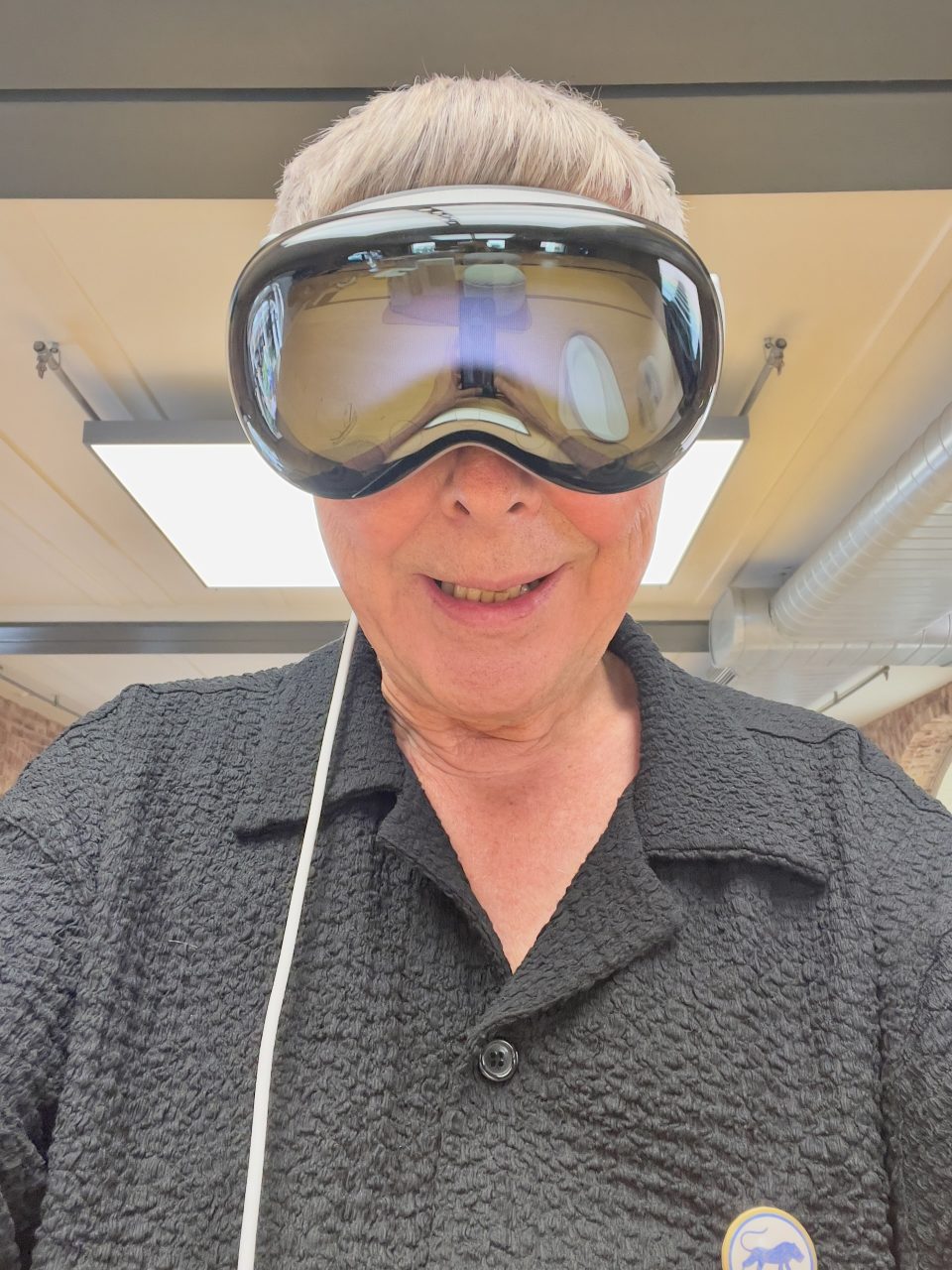
Pleasant but underwhelming is all all I can say. The fact you can “see” through the goggles (if you want) is excellent, so it is easy to forget you are wearing them. The eye navigation and finger clicking worked great, as did window manipulation. Normal photos looked no better than a good hi-res monitor, still lots of oversharpening. Asked to zoom in on a still, it looked over processed and smoothed as usual, like most iPhone pics. The iPhone panoramas were nice to move around, but of course displayed classic jpeg artifacts. The 3D photos and videos looked better through the stereoscopic glasses, apart from some dodgy backgrounds. Still, you need a Vision Pro to see them properly. Apparently the 3D media were all taken on iPhone 15, so that was good. I was then encouraged to watch several Apple video promo’s. Of course they looked great, they have spent millions of dollars on them, so they should. Did they look better than normal video, no they looked like normal 4K video to me – that is high quality but with some special cinema adaptations.
Then it all went wrong. I went to my hi-res gigapixel website and you could not make a fullscreen view. Not only that, the resolution was not even HD, it was like viewing the internet in 2001, 720×480 pixels. I should say that I was able to actually navigate my panoramas, they just looked awful. Ok, so then I tried my 4K videos on Vimeo, same result. I actually cried out “appalling”. I then asked if there was download throttling. No response. I then asked if Safari didn’t work properly. No response. If this is actually how it works, Vision Pro is not ready for primetime. If it cannot play a normal 4K video, what is the point? If you can only properly view work specifically made for the Vision Pro, I would say wait a few years.
I should explain here that throughout the Vision Pro experience there is a personal Apple Specialist who monitors your actions and your views on a remote monitor. You talk with each other during the demo. Undoubtedly this person is following a script, as a result they do not appear to be able to answer actual questions. Not only that, but my Specialist was wearing a mask, which did not aid communication. (Have I got Covid, have you got Covid, either way it is unpleasant). I also spent 10 minutes wearing the device with an error message, while the Specialist disappeared, so probably not their best ever demo. However, that did give me time to take the selfie above, so thank you!
Nevertheless, I can see the appeal of this device in certain circumstances and enjoyed the experience. I did manage to use the virtual keyboard with eye navigation, a bit like using an iPhone keyboard in fact. As you might expect from goggles, by far the most impressive part of the experience was the best 3D I have ever seen. This is only version 1…hope it gets better!
This is the camera, a Minox 35 GT from 1981, that I always carried with me for several years. It was tiny, only 100mm wide and 31mm deep when closed, it weighed just 200g, yet took standard 35mm film. It felt like a spy camera, I was always ready. In those days only professionals carried a camera 24/7, you were the exception.
Today it is no longer in production since it has been well superseded by the power and ease of use of our ubiquitous phone cameras. Yes, we are all photographers now and all those photographs are free at the point of use. How times change, how quickly advanced technology becomes redundant.
In the 80s to become a photographer you had first to build a darkroom. That was the only way to process film fast enough to be of commercial use, without spending a fortune on poor quality rush processing. So it took maybe an hour to process film and then maybe a couple of hours to make prints, and that was with a film drier and a Kodak drum print drier. Remember this was just for monochrome. Every click cost money, many jobs would be completed on just 1 roll of film, that is 36 pictures on 35mm or 12 on 120 format. Nowadays I may take 500 pictures or more, there are so many more decisive moments these days! And they are all free…
The fastest film available was normally Kodak Tri-X or Ilford HP5 at 400 ASA, often push processed to 800 ASA. There was Kodak Recording film at 1250 ASA, which had an enjoyably coarse grain, but that meant it was reserved for specialist uses. I was also an early adopter of Ilford XP1 400, a chromogenic C41 35mm film with its own specialist developer. It had so little grain and such good gradation, that art directors and picture editors thought I was using medium format, so I loved it.
As for colour, I adopted transparency film, which had a fast turnaround time of 2 hours at a good E6 processor like Primary Colour. Of course the transparency, once mounted, was the final product ready for production, there were no negatives or prints. As a result the initial exposure had to be spot on, often bracketing of exposures was necessary. Alternatively you could get a clip test for the first few frames of the roll, and then order the development to be adjusted as you required. Good colour film was always slow and the best was Fuji Velvia which was only 50 ASA. Hence I often had to use a big hammerhead Metz 45 flashgun when out on location. Most transparency films above 100 ASA looked washed out, compared with Velvia or Fuji RDP 100. A particular issue for me was tungsten balanced film (3200K) for use at concerts. The only real choice was Kodak Ektachrome 320T, but I never liked it much. Otherwise there was Fuji 64T, excellent on a long exposure, using a tripod at night.
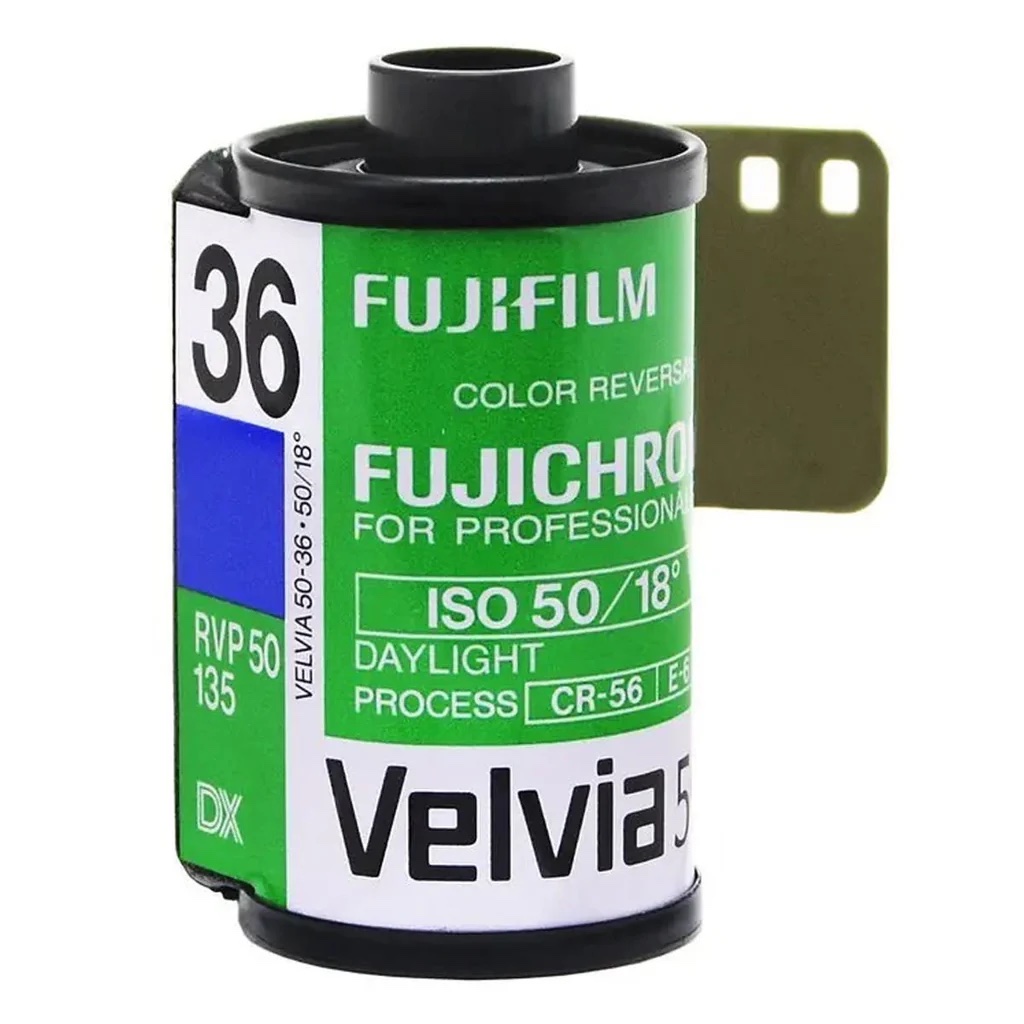
So the days of worrying about ASA, colour balance or even exposure are over. Photography sure has become easier, if not child’s play. Take a RAW format photograph and all those variables can be adjusted, no accuracy is required. The dynamic range of a good digital camera far exceeds film, an exposure 5 stops out can be recovered in Lightroom or Capture One, any colour balance may be used, and digital photos can now look great at 3200 ASA. My Minolta Flash light Meter IV is totally redundant, as are most of my photographic skills. Yes we are all photographers now…
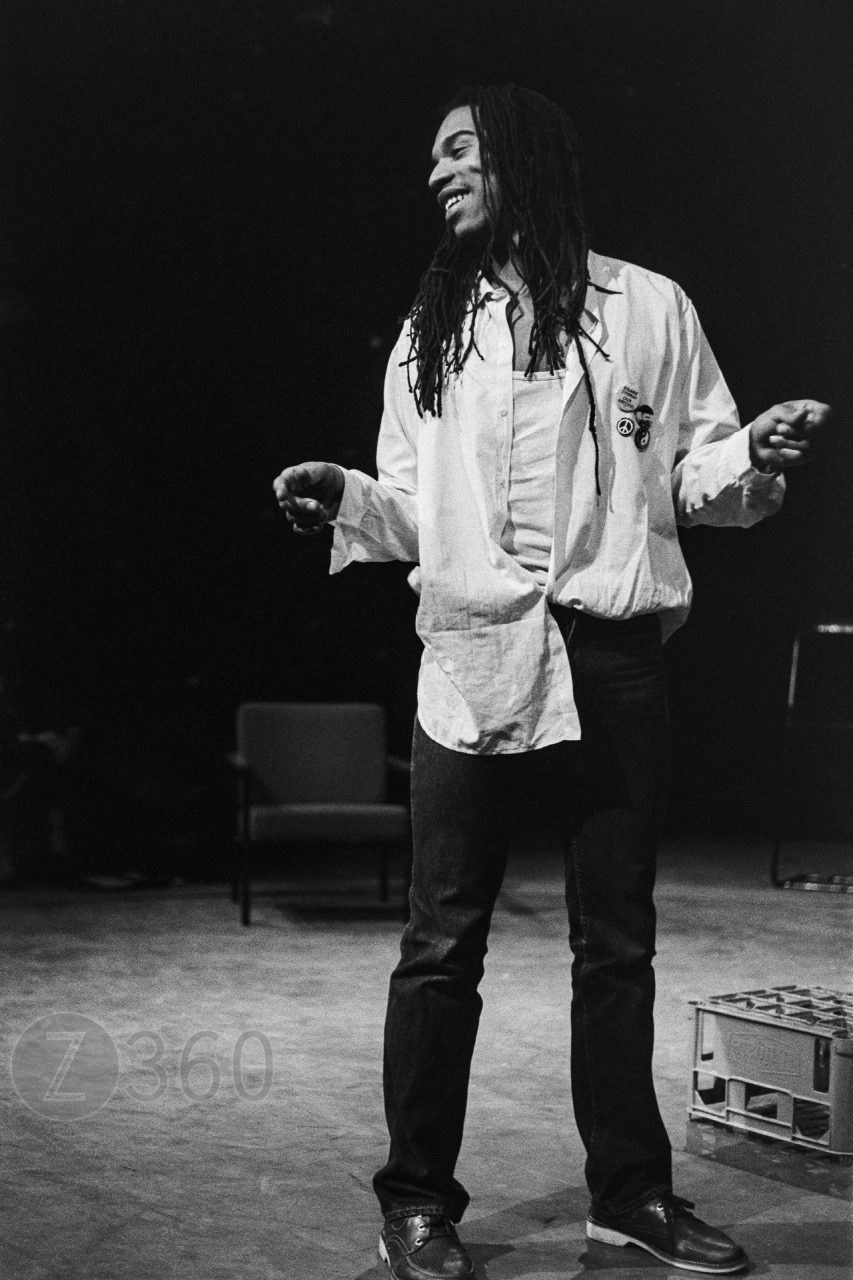
The sad and much too early death of Benjamin Zephaniah this week prompted memories of the first time I saw him way back in 1983 at the Angels of Fire Festival. I was excited to see him since I had heard about him through the New Musical Express, which was my reading matter, rather than the Poetry Review. To put this in context, Angels of Fire was a six night poetry festival featuring new performance poetry and upcoming modern poets, at the Cockpit Theatre near Marylebone. The choice of performers was certainly prescient and varied, since several of them went on to have long careers. This festival of poetry, which gave me an excellent grounding in many different voices, was shaken up by the rockin’ dub protest poetry of Benjamin, which seem like a righteous breath of fresh air at the time.
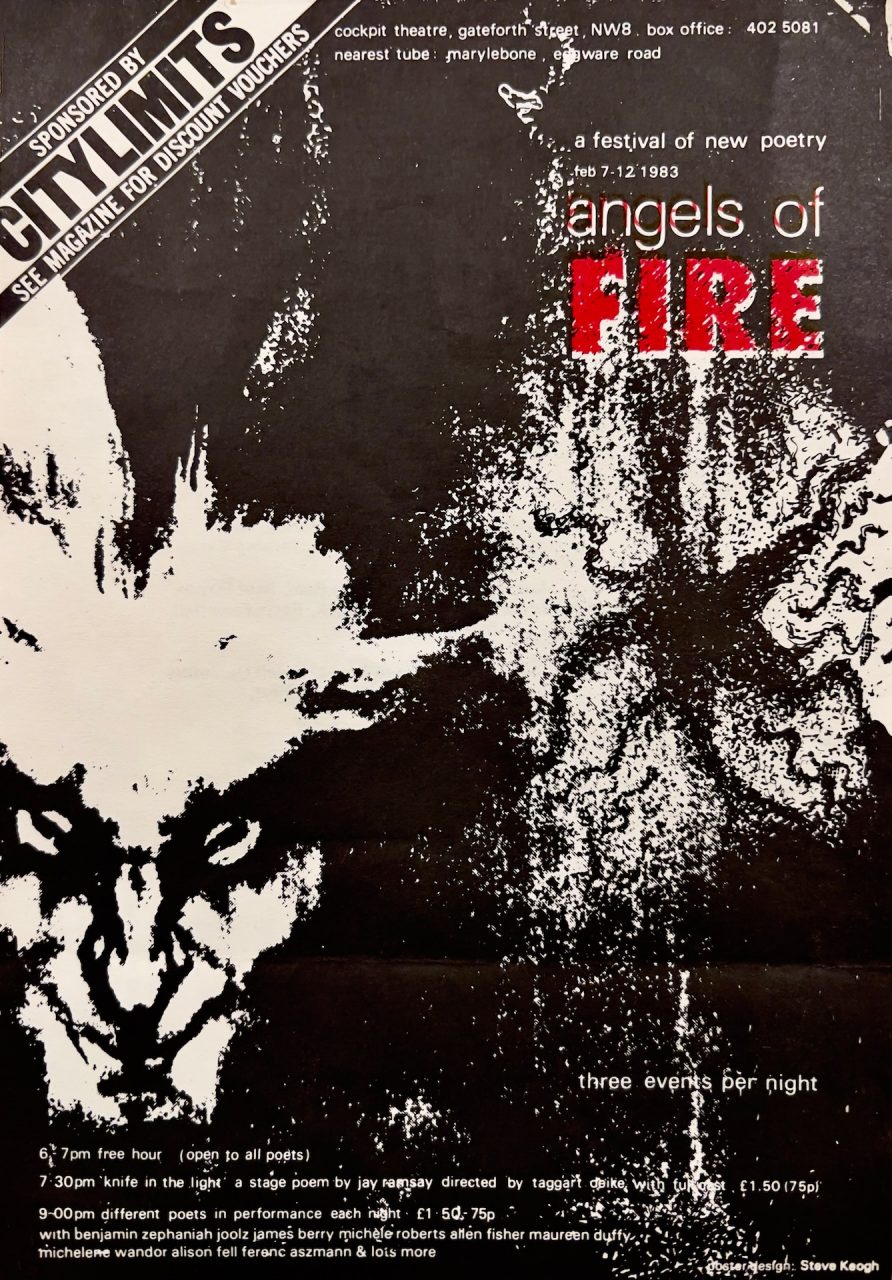
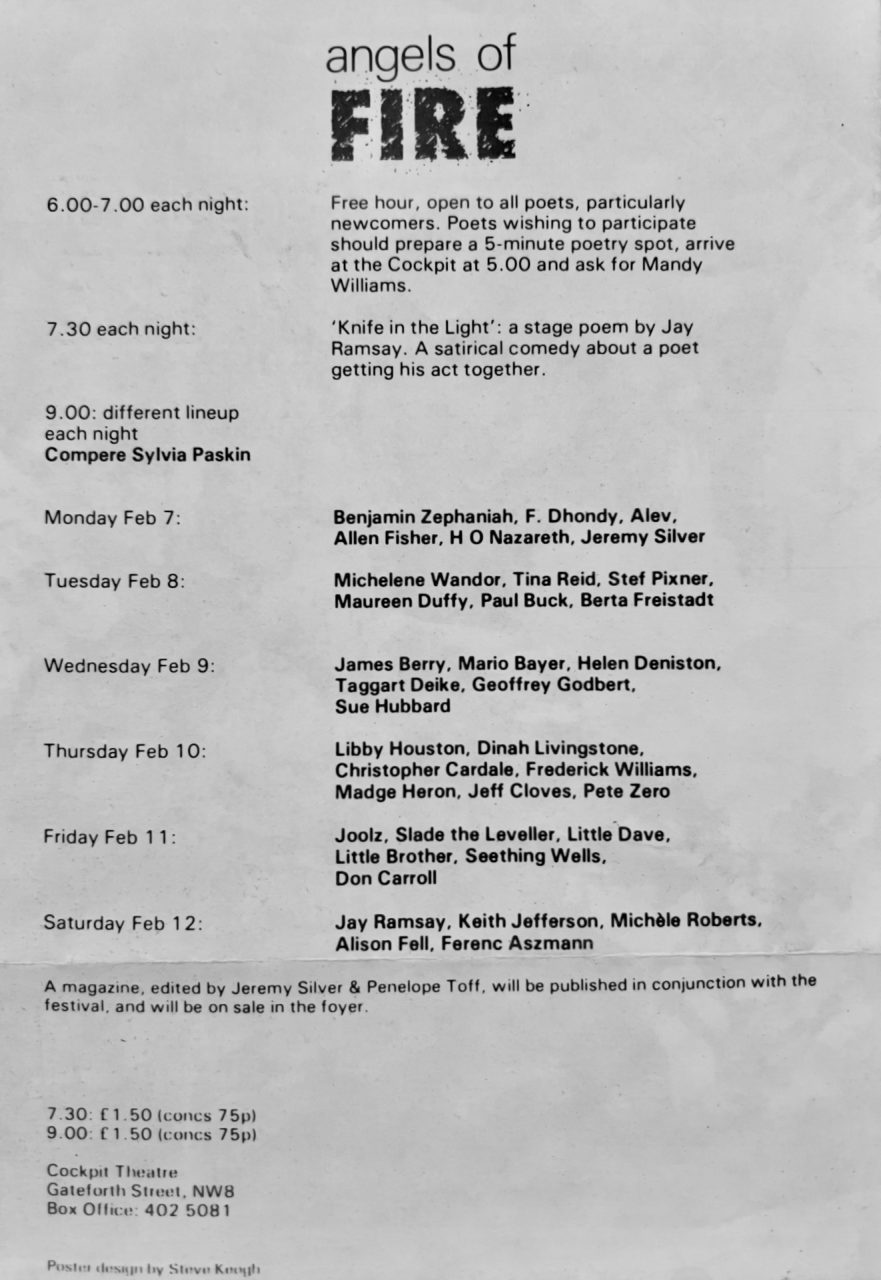
I went to every night of the festival, since I regarded it as my first documentary photography project. I did not really know what I was doing, but was allowed to take photos as a member of the audience (times have changed…). Of course I was not being paid, but I managed to wangle my way in for free for a few nights through British Library Sound Archive contacts, who were recording it. I felt at home there since I had worked at the Cockpit as a Stage Manager. Fortunately the festival was sponsored by City Limits, a London listings magazine, and I made some early print sales, with the photos being used in their poetry column. Eventually some of theses photographs were exhibited at The Drill Hall in Chenies Street WC1.
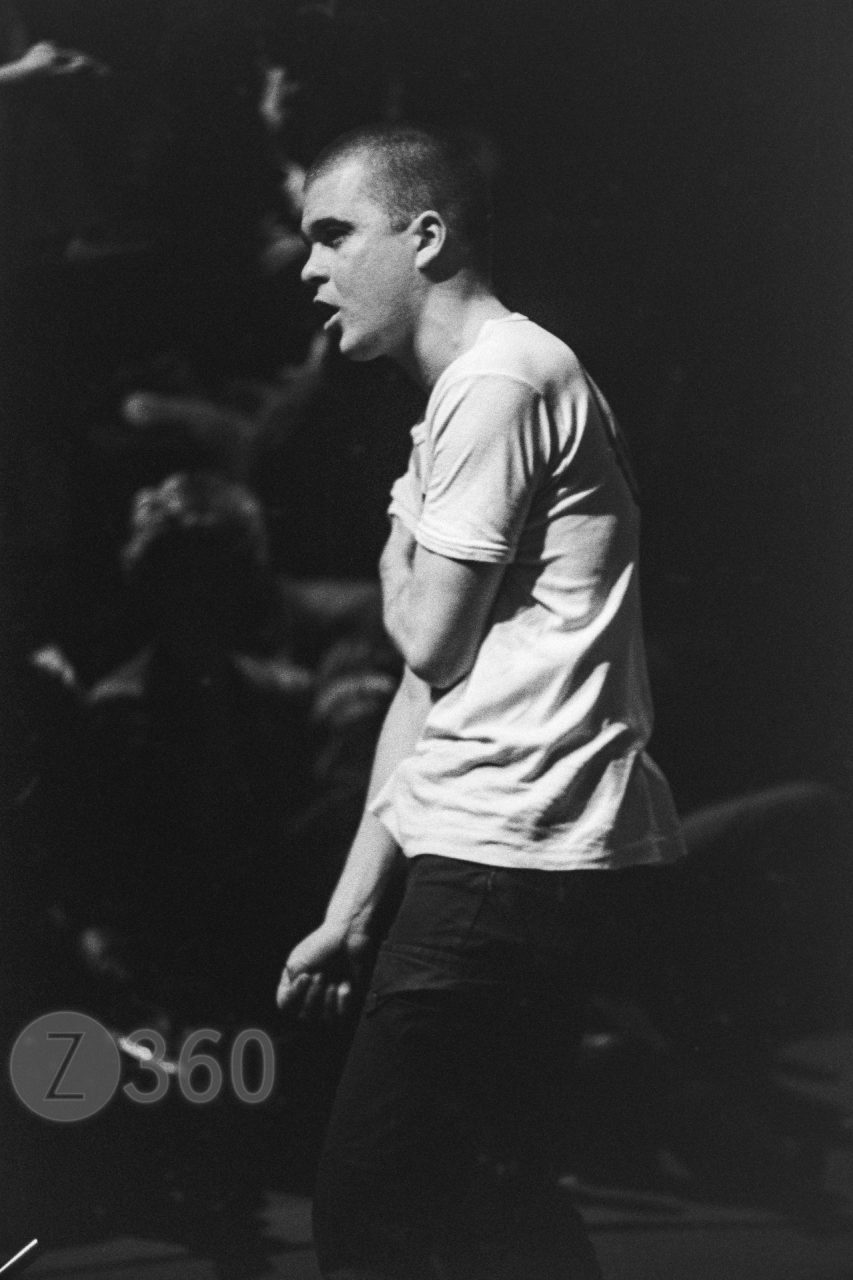
I was also looking forward to seeing Seething Wells (aka Steven Wells 1960-2009), who lived up to his moniker, along with other early ranting poets such as Little Brother and Joolz. The more refined feminist poetic tradition was also represented by Michèle Roberts and Alison Fell, while a notable contemporary wordsmith was Jeremy Reed, full of Bowie references. The world of sound poetry was not forgotten either, with the appearance of the legendary Bob Cobbing (1920-2002), later to be seen at The Klinker in Islington. Here are some of the photographs I took of these poets:
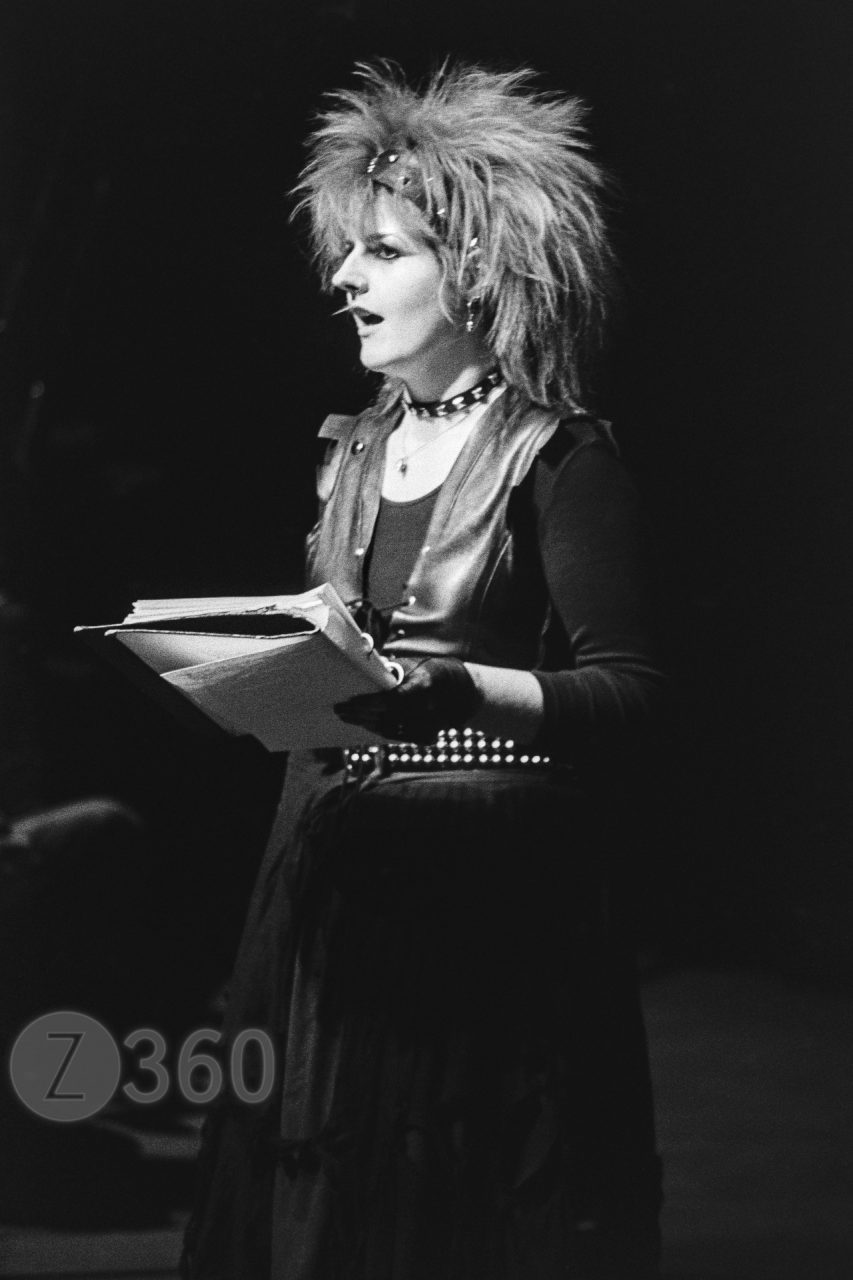
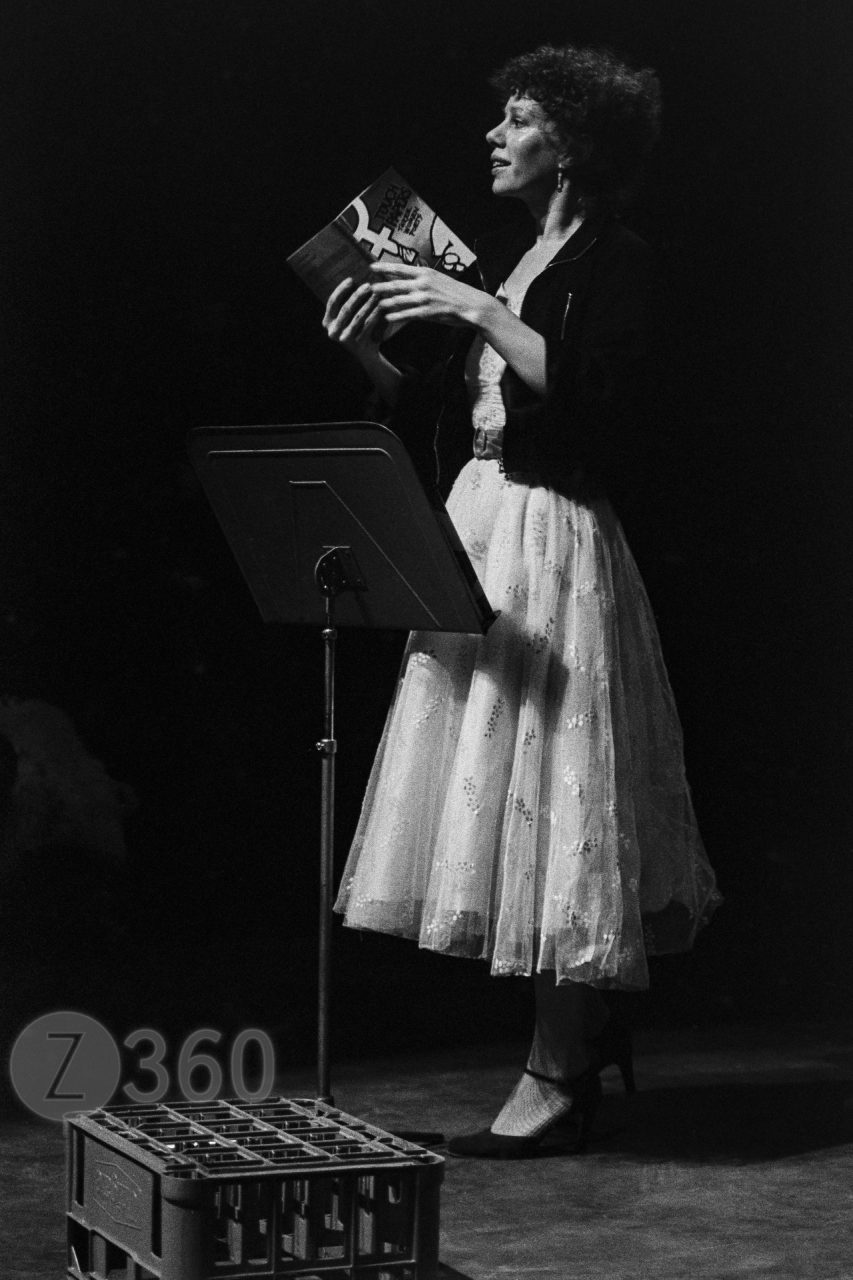
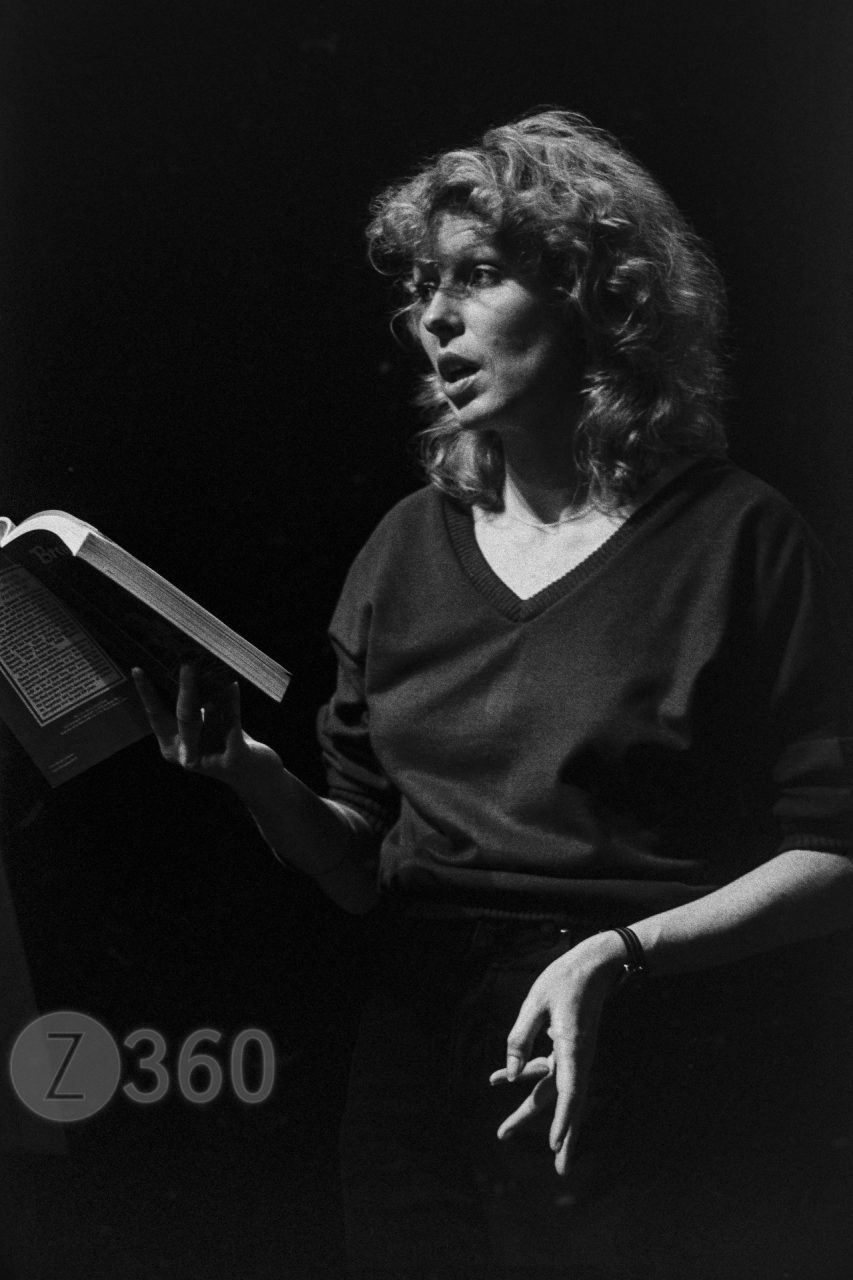
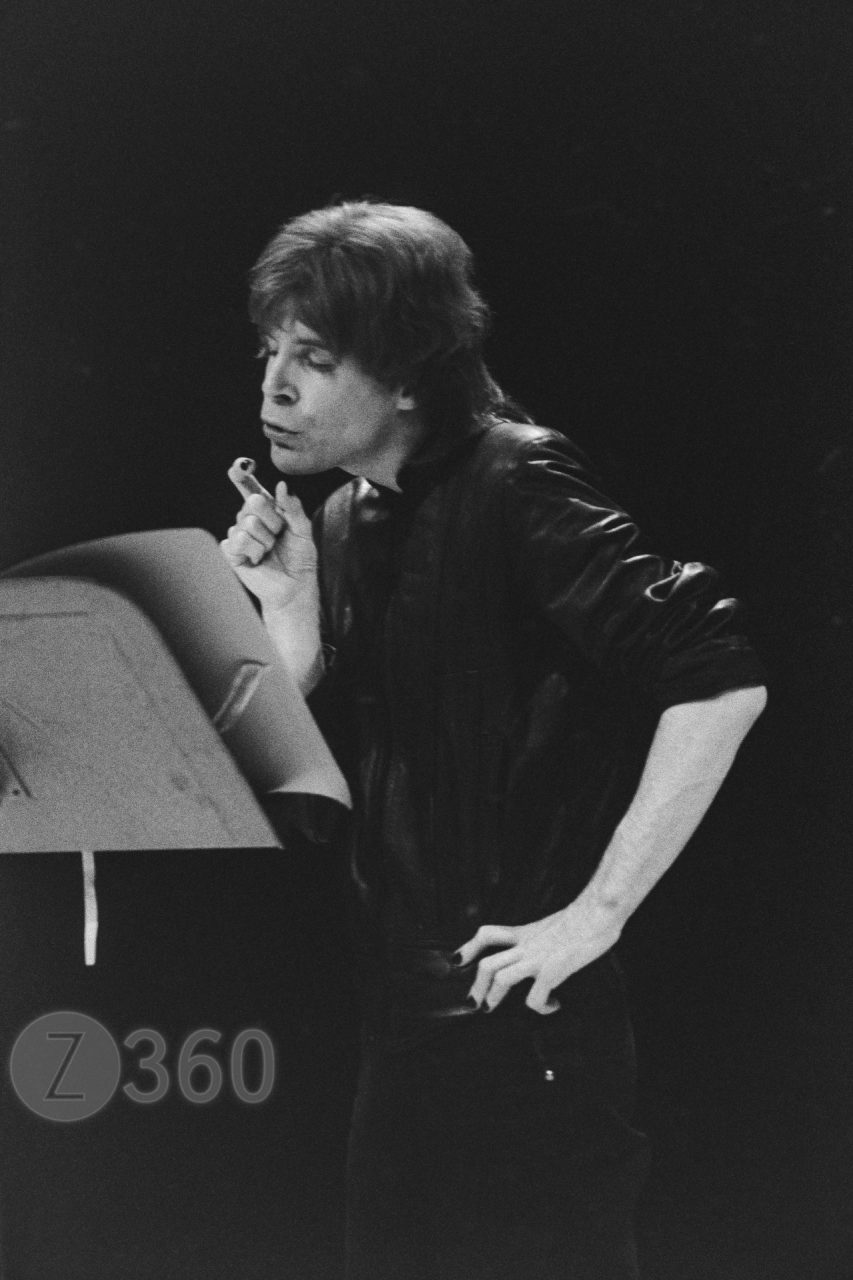
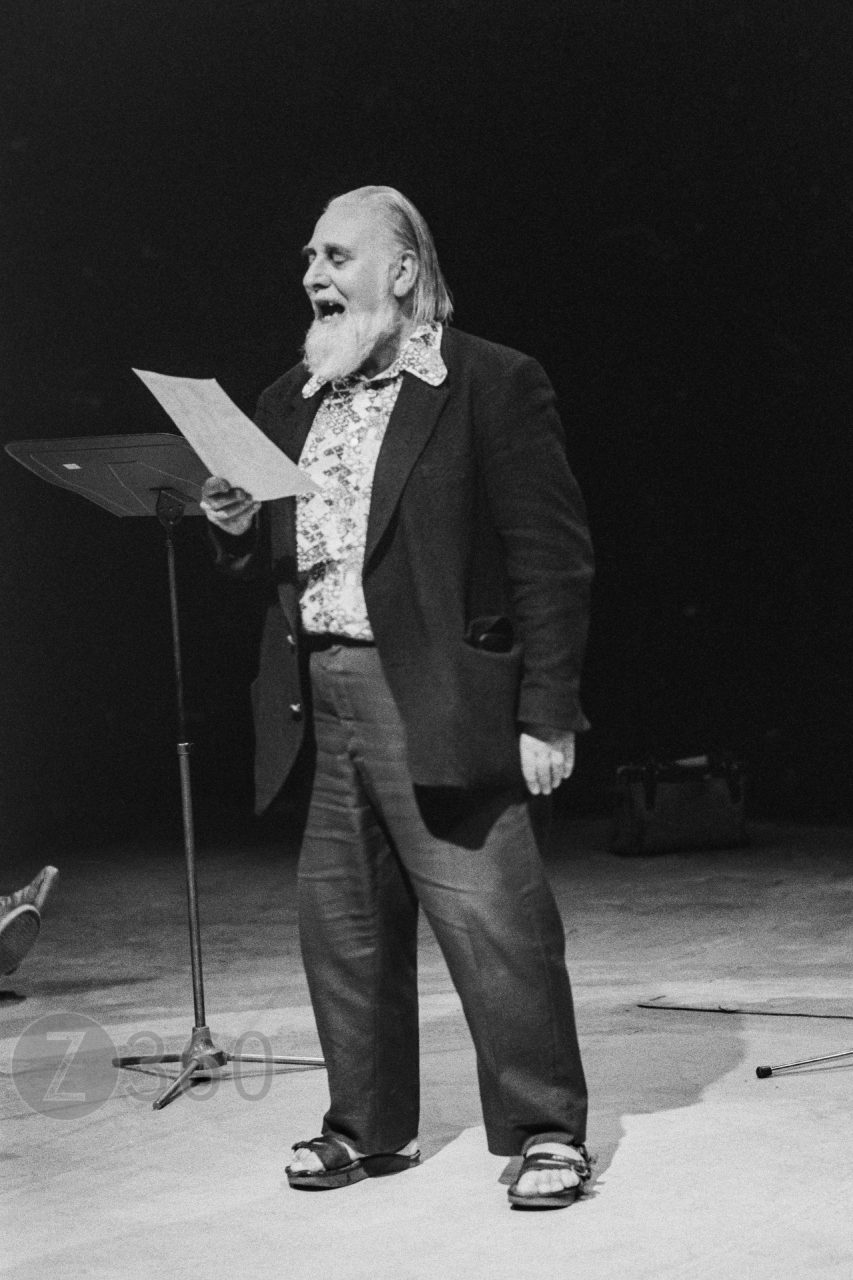
I was heartened to see Benjamin Zephaniah become become a Professor of Poetry and part of the National Curriculum, turn down his OBE, and always act with generosity, wit and humility. Here he is in full flow at the ICA a year later, I believe.
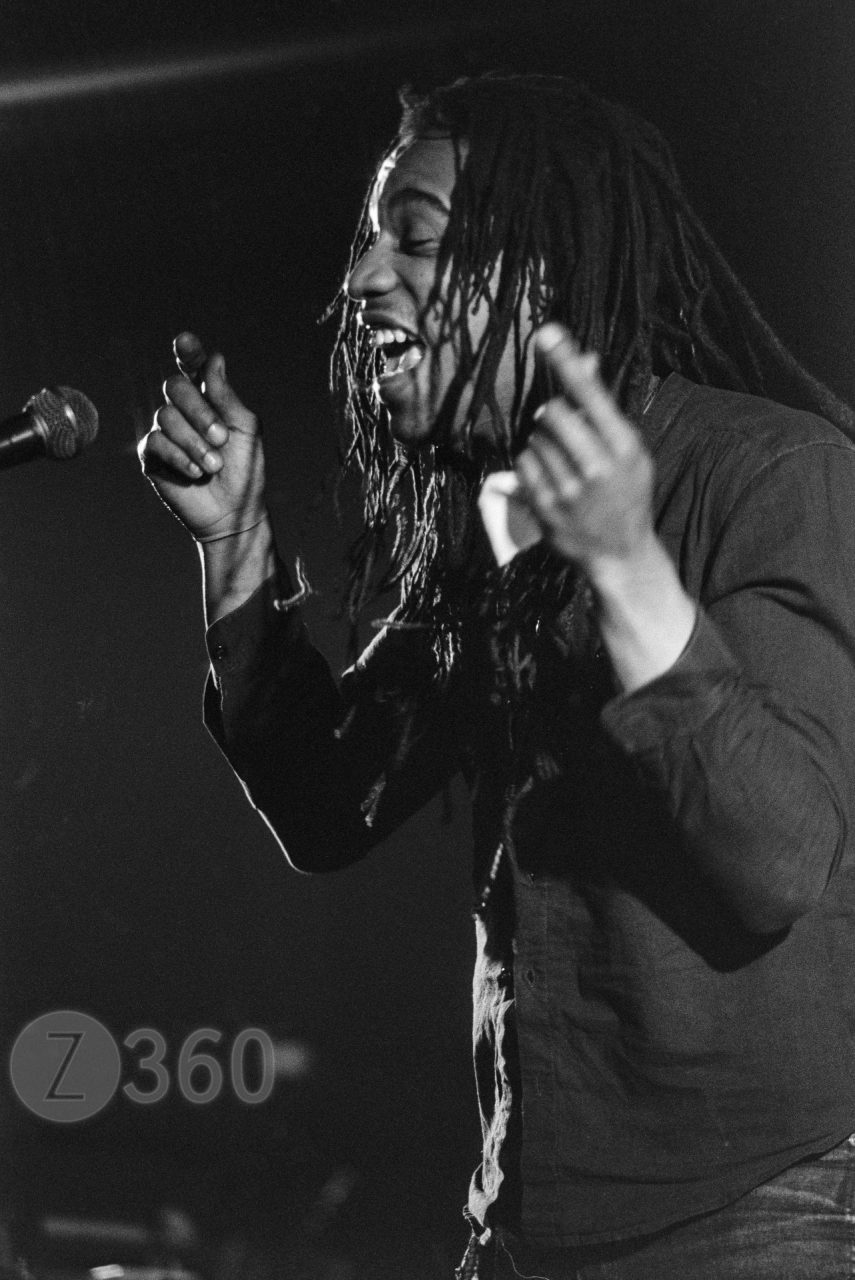
†
In 1982, at the instigation of Patrick D. Martin, I became the photographic co-ordinator for Robodevco. This later became The Roboshow, where a prototype multimedia computer controlled a forty-three screen, three dimensional sound experience. It was hosted by ‘Q’, a virtual robot at a large warehouse off Torriano Avenue in Kentish Town, London, 1985. It proved to be a “a completely new screen sensation”.
Before the Roboshow there was the Technocab, the most enjoyable part of the whole experience. This was a blacked out London taxi cab containing a Trinitron TV and a BBC computer. Due to the size of the huge cathode ray tube monitor it was a one person experience with binaural headphones, like a solo cinema. The cab would start up as if going on a journey, often dry ice was involved, sometimes we rocked the cab to simulate movement. A taste of what you would see (2 mins in) is contained in the following video, the Roboshow Electronic Press Kit. This low-res video features my stills animated with Bob Lawrie of Blink Productions, as well as the triggered micrographics of Richard Brown.
On the strength of this intense experience nearly a million pounds was raised to fund the Roboshow experience, which was intended to be franchised. A prototype multi screen cinema was constructed and the images would fly around the space in a truly fresh and disorienting manner, after being introduced by Q, a TV robot. Out on location Q was sometimes an American football style roller skater with a video boombox, who featured in the video shot by Charlie Arnold.
The Roboshow garnered a lot of good press, being featured in The Observer, The Face and New Scientist. This description of the show was published in the Evening Standard, January 1987:
“We went into a room that seemed smaller than it actually was because the 20 chairs on the raised platform were pointing towards 50 TV screens that ran around the front and side walls. There was one big screen in the middle.
The lights dimmed.
A rollerskater zoomed straight across our line of vision from left to right with an accompanying sound effect that seemed almost three dimensional. The show had begun– and for the next seven minutes images flickered, jumped, danced and propelled themselves across the screens. Sometimes it was the same picture. Sometimes it would break up so you were seeing the same thing from divers angles on different screens.
It is an experience 50 times as intense as watching regular TV because of the interplay between the screens and the meganess of the sound system.”
These are some of the quotes from the Robodevco Press Pack, which demonstrate why Roboshow garnered so much attention:
“Totally wild … any explanation would fail. to do justice to this experience”
Bruce Dessau, City Limits, Aug 21 ’86.
“The next medium to take over where Cinema left off’
Televisual, Nov ’86.
“Q makes Max Headroom look about as wacky as Sooty”
Direction, Oct ’86.
“Superb -look forward to seeing it in Piccadilly Circus”
Juliet Rix (BBC Newsnight).
“The technical possibilities are extremely exciting”
Roma Felstein (Broadcast).
“Very impressive”
Barry Fox (New Scientist).
“The most important development in Entertainment since they got rid of the Proscenium Arch”
Anthony Horowitz.
This is my photograph of the actual prototype Roboshow in Kentish Town. It was intended to expand the show and run it at Paul Raymond’s Revuebar Boulevard Theatre in Walkers Court Soho, London. Unfortunately this never happened.
It is important to remember that all this was happening before the advent of the internet, digital cameras, HD video or flat screen monitors. In fact analogue video was equivalent to 720×576 pixels at best, that is 625 (576 visible) interleaved scan lines in a 4×3 format. At the time Video 8 with it’s small form factor was the most exciting camera development, but most video was filmed on large and heavy U-matic cameras. Nevertheless The Daily Mirror observed that “the revolution starts here… Shock the music industry and change the world of video”. For an in depth explanation of all this technology the article in The Games Machine magazine, dated August 1987, reveals the many participants and innovations involved:
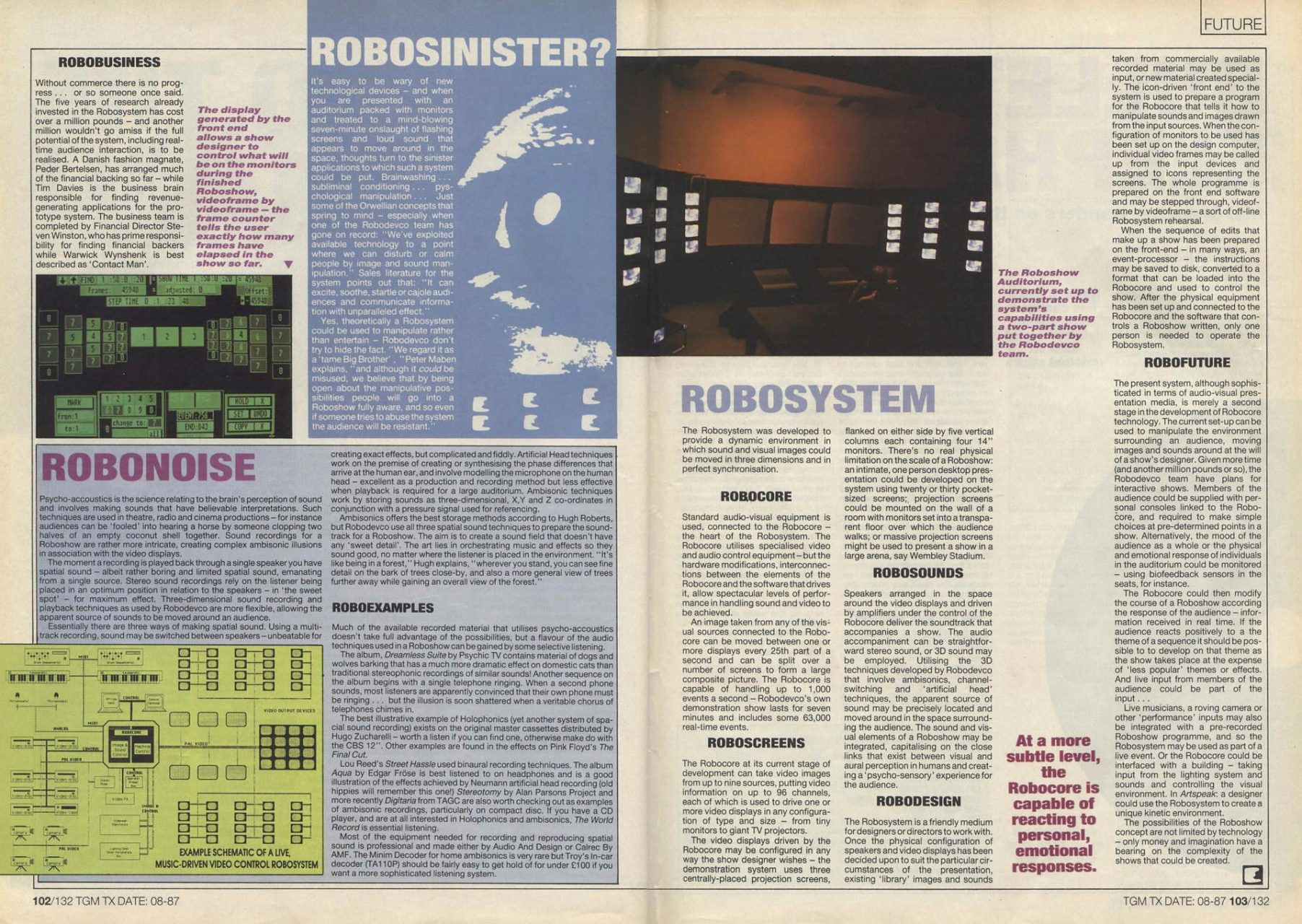
As well as the visuals, audio was an integral part of the experience. A holographic cassette was produced with music by Phil Nicholas, a Fairlight programmer, later to work with The Willesden Dodgers, Stock Aitken Waterman and Def Leppard, among many others.
Here is a promo pic of Patrick Martin, Phil Nicholas and Marcus Kirby taken at Robodevco headquarters:
By 1985 I was fortunately working for New Musical Express and so mostly avoided the machinations involved when new directors and accountants were appointed to Robodevco. The freelance crew (who made the Roboshow) were encouraged to sign contracts to make them rich when the project succeeded, yet were to become liable for large debts as bank guarantors without real equity. Thankfully I did not sign up. Ultimately, after the failure to produce an actual show, this led to arguments about the structure of the project and ultimate dissolution of the company. The directors became XYLO and took the technical assets which opened at a disco called Zhivagos in Darlington in 1988. RIP.
Meanwhile Patrick regrouped and formed Psychovision with a new Technocab, but this time in a Dodge van. I went to the grand unveiling at Chelsea Harbour, but disastrously the new van was not yet finished. Shamefully the many punters were told it had broken down on the Westway. Eventually the Dodge Technocab aka Psychomobile did surface at Covent Garden:
There was some mitigation for the previous disasters when in 1992 Psychovision created a 5 screen show for the Victoria & Albert Sporting Glory Exhibition which was later screened as part of the 1996 Atlanta Olympics. In 2011 Justin Kirby made Roboshow Reboot, a website to document this story, but it has long since disappeared. Here is a brief 44 second clip of my submission for this. It sure all was groundbreaking fun while it lasted…
To conclude here is the full interview Richard Brown made for Roboshow Reboot at the Rewire 2011 conference, which sums up the whole story very well:
Or Why I punched the Wardrobe
In 1985 I photographed Robert Smith of The Cure at his record company offices in Marylebone, London for Sounds. He was a sweetie, and all seemed to go well. However, for the first time ever (for me at least) the photos were taken “on approval”. This procedure was totally antithetical to the way I worked and to what I believed being a photographer was. However the photos were intended for the front cover, so I thought fine, no problem. It did mean I had to hurry more than usual and to make a presentation box. In order to protect the fragile original Hasselblad transparencies I mounted them in expensive glass 2.25” slide mounts. There was no time to make costly duplicate medium format transparencies. The black and white prints were proofs and not the intended final master prints.
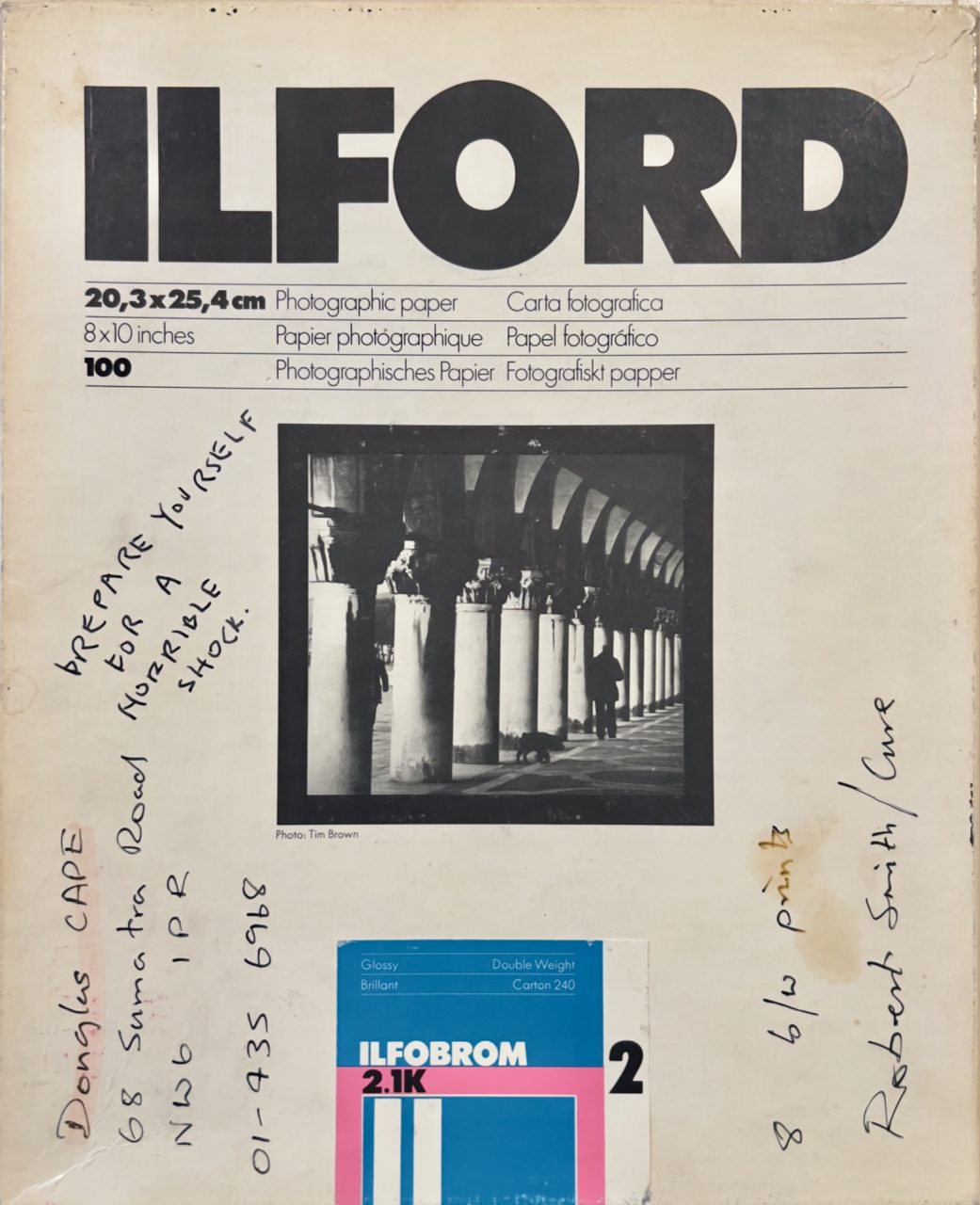
Well I guess the story can be told now. To keep it simple this is what happened – he destroyed the photographs he liked. That is THE WRONG ONES. When I say destroyed I mean he smashed the glass of the slide mounts and then proceeded to cut up the unique and original transparencies into tiny shards. I received in return a box of broken glass and slivers of cut-up film. Since the photographs were for the front cover, these were the best ones, the colour transparencies. Sounds magazine was not interested in shreds of film for their cover at the time. Nor did the magazine, record company and PR organisation wish to make their pop star appear really stupid, so there was a big hush-up.
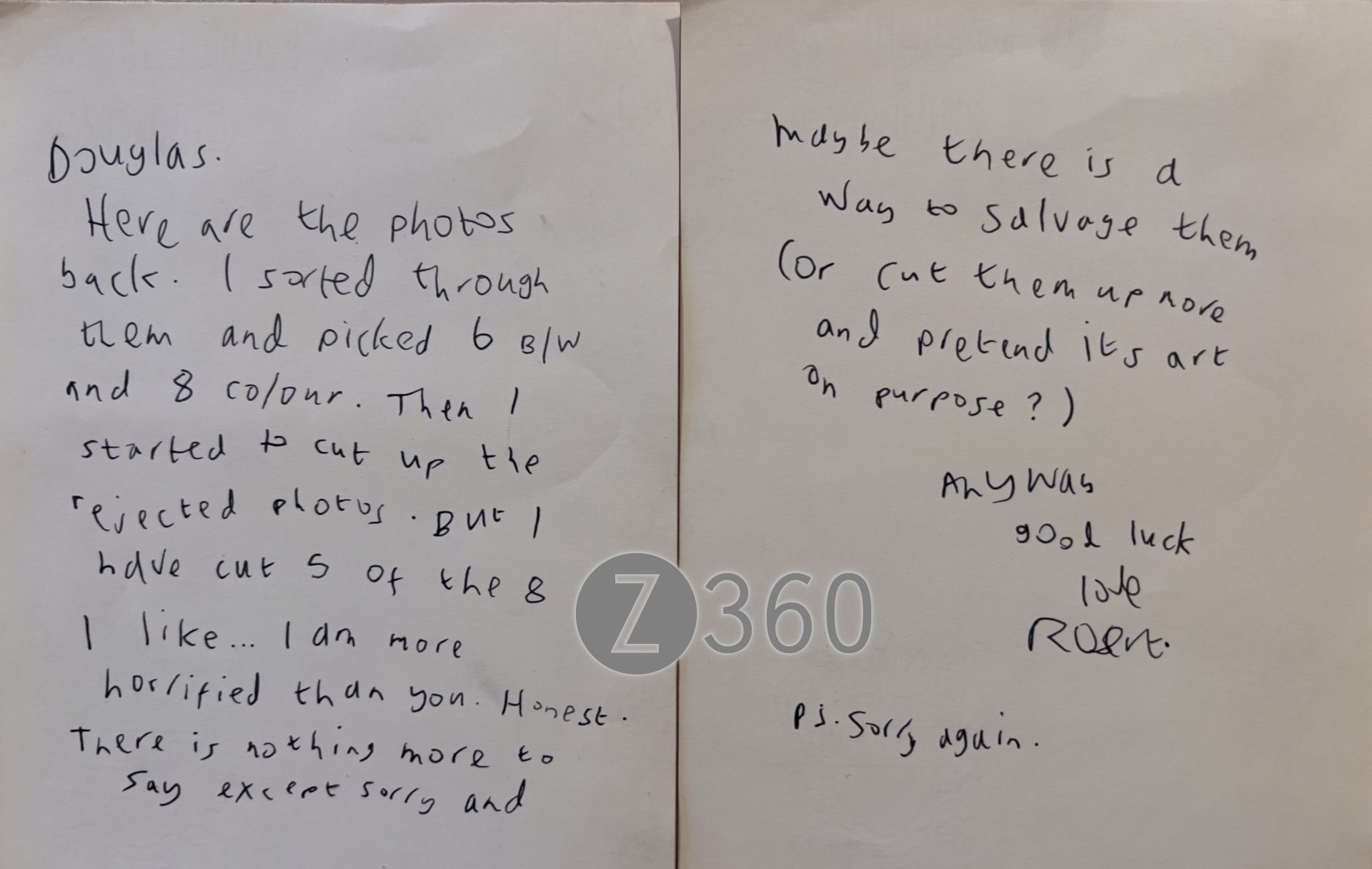
I was remarkably angry and punched a wardrobe much too hard. I could see which way the wind was blowing in the celebrity industry and soon changed my style from portrait to commercial studio photography of inanimate objects. At the end of the day a perfunctory sum was paid in recompense, months later. To me that was not the point at all, I had missed doing the cover photo and everybody seemed to think it was somehow my fault. I guess it’s all down to the pecking order, but no-one has the right to destroy someone else’s original work.
In those pre-digital days there were no scanners or any easy way to use the shards of film I was left with. Now 37 years later I have relaxed enough to open up this can of worms and follow Robert’s advice. Yes here is the cut-up he suggested making all those years ago. It might be “art on purpose” but it’s certainly not a Sounds cover.
So what are the advantages you may ask. Quite simply the most important reason for me was to have access to 4K video, so that my cameras could compete with my iPhone. Now that I have a Nikon Z7 and Z50 I have found a plethora of other reasons for the upgrade. When I saw the the power of 4K video on my iPhone XS , it was apparent my old Nikon D800 was simply outclassed by the new computational video options in my iPhone.
However this iPhone has only one usable lens (the telephoto is lower quality, although I hear they have improved), and I found this very limiting. Now I have access to lenses from 7.5mm to 500mm, lots of options. Not only that, but due to the short flange distance, many vintage lenses can now be easily used with an adaptor. Talking of adaptors, the Nikon FTZ adaptor for G lenses works very well retaining full AF. However it is very bulky with a large box sticking out below the camera, which I find quite annoying, both for tripod and handheld use. (Update: There is now a version without the large bump). If you are using an old lens without AF, I recommend using a dumb circular adaptor. As for Z lenses, the new Nikon S lenses are indeed of spectacular quality, if rather expensive. Much better value and more entertaining are the third party Chinese lenses from Pergear, TTAritisan, 7 Artisans, Laowa and Meike among others. I have bought several of these metal manual focus lenses, in particularly fisheyes and wide angles, and optically they are excellent performers. In particularly my TTArtisan 11mm f2.8 fisheye was a lot sharper than my old faithful, the Nikon 16mm f2.8 fisheye, much to my surprise. The edge performance was a league above, although 11mm seems a misnomer, having a nearly identical 180º field of view to the Nikon 16mm. There are now some Chinese AF lenses from Viltrox, at least half the price of the Nikons, which have been well reviewed.
So much for the lenses, the real surprise was actual usage. For 30 years I have only used my cameras in full manual, locked ISO, spinning the speed and aperture dials as necessary. Now I have discovered the power of Auto ISO (still available in Manual), and am already getting lazy. With the power of dual gain sensors it does not make much difference to noise and quality when shooting in Raw whether the ISO is 100 or 10000. I am aware that for full quality I should be below ISO 400, but can you tell the difference? Anyway the speed of use, once fully set up, allows me to nearly shoot at random. The amount of information in the electronic viewfinder (which takes some getting used to) is highly informative and can be rapidly changed. The peaking function is invaluable for manual lenses. I trust the AF and exposure (-1/3) and of course all the pictures are now free.The latest sensors are amazing, I remember never shooting above ISO 800 on my Nikon D200. Meanwhile these cameras are truly optimised for video, the focus no longer jumps or hunts, aperture changes proceed as if click-less, even changing shutter speed is done smoothly. In addition you have the speed and flexibility of a touch screen, articulated monitor and best of all, silence. A minor annoyance are touch buttons on the Z50 monitor, often accidentally touched by my nose since I am left eye dominant. They have moved them on the similar spec Nikon Zfc. The autofocus is great, with a few confusing options, wide area-s seems to suit me. Mirrorless cameras tend to use more battery and require attention since while the camera is on the monitor is on, which has caught me out a few times. Always switch off when not using and it easily takes hundreds of shots and an hour of video (with a restart). One advantage is that they can be recharged via USB without the mains adaptor.
In conclusion everything feels quiet, smooth and light, that’s all good. Do they take better photos than my old D800? Perhaps, but the benefit is really apparent in the sparkling video, tracking autofocus and flexibility of use.
Before the advent of Extinction Rebellion, mobiles and the internet there was a word of mouth demonstration in September 1983 which brought the City of London to a halt. This was followed by 2 more demos in March and September the following year. I attended and photographed the first two events, which can be seen here.
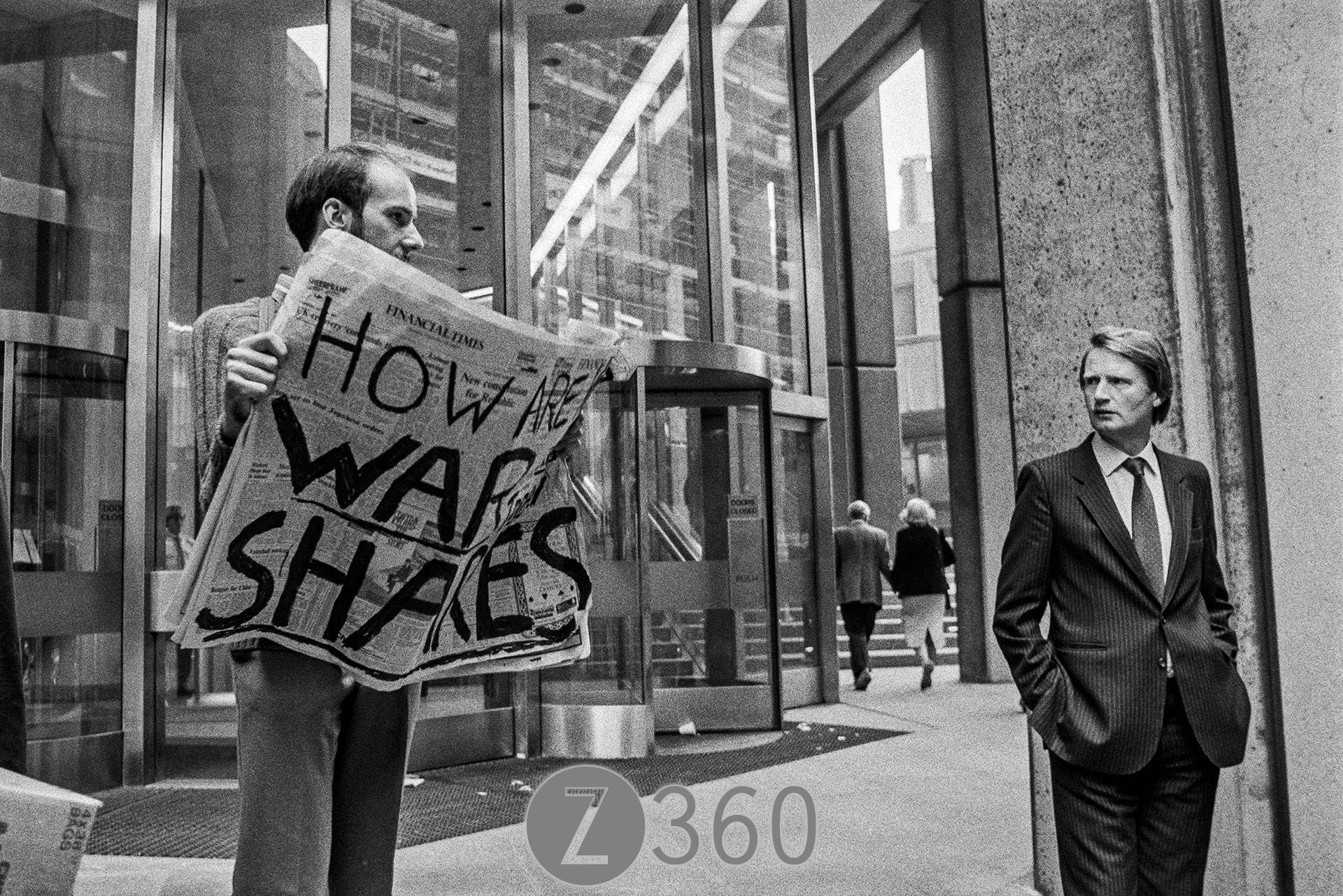 The first demo was truly glorious and anarchic, since it was so unexpected. The whole area of the City of London became a “Carnival Against War, Oppression and Destruction”. Everywhere you went there were groups pf punks, anarchists, musicians and performers barricading banks, The Stock Exchange, Guildhall and The Royal Exchange. The Police were quite unprepared and the protestors roamed around freely, or held random sit-down protests.
The first demo was truly glorious and anarchic, since it was so unexpected. The whole area of the City of London became a “Carnival Against War, Oppression and Destruction”. Everywhere you went there were groups pf punks, anarchists, musicians and performers barricading banks, The Stock Exchange, Guildhall and The Royal Exchange. The Police were quite unprepared and the protestors roamed around freely, or held random sit-down protests.
Later in the afternoon more police and then the mounted police arrived, but despite many arrests the protest was mainly conducted in a peaceful manner.
The second demonstration in March 1984 was a different matter. This time the police were ready and out in force. You could be arrested for simply “stopping” in the street and the demo was confined to the environs of The Royal Exchange. Protestors were often arrested or blockaded just on the way to the protest. A massive kettling operation took place at The Royal Exchange, leading to violence and many arrests.
Personally I had to try and avoid being kettled, while also avoiding the police who would try and steal my camera at any opportunity. Luckily it was on a strong strap and I managed to wrestle it free from their grasp. They were animals that day, there are several photos of them strangling protestors. One famous photo by David Hoffman of a photographer in a chokehold, led to a £4.000 payout at the ensuing trial.
It was a miserable day, and a downpour in the afternoon doused spirits further, which was probably a good thing all round. Apparently the third demo was so well policed that hardly any demonstrators made it to the City.
There is not much good documentation of these protests on the web, but these links should provide some good info:
Wikipedia Stop the City
History is made at night
There are also some grainy and lo-res videos:
Stop The City – News Reports 1983 / 84
Roddy Melville Stop The City 1984
Stop The City 83-84 video by Mick Duffield and Andy Palmer (Crass)
“I move not without thy knowledge”
Epictetus (c. 50-135 AD)
How do you dance when you are 14? How do you even know what to do, without looking stupid? My solution was to copy the girls, they all seemed so self assured as they shuffled mellifluously. I was in the Church Hall of St James Church, Birkdale, Southport. It was at least dark, which helped my embarrassment, since this was before the arrival of the flashing disco lights. It was my first experience of a discotheque, and my first dance song was the hit of the day, Sugar Sugar by the Archies. This classic of bubblegum pop had a moronic and repeating rhythm, which seemed to make dancing easy. I was already aware it lacked the danger of say The Rolling Stones or even the funk of Tamla, but this was after all a church disco, and even the suggestion of kissing a girl seemed quite outré, in the building which had been my Sunday School. Well I had broken the spell, and managed to dance in public, although no-one could see me, all for the better. The narrow horizons of the Church Hall disco would soon spread out into the brand new world of the discotheque, which would later become the de facto night out. It never failed to amaze me that I was listening to the most orgasmic song ever, Je t’aime by Serge Gainsbourg, while next door the the vicar would be sermonising against all this sexual behaviour among young people. Down the disco was the only place I could hear this song, since I did not have a record player and it was banned by the BBC.
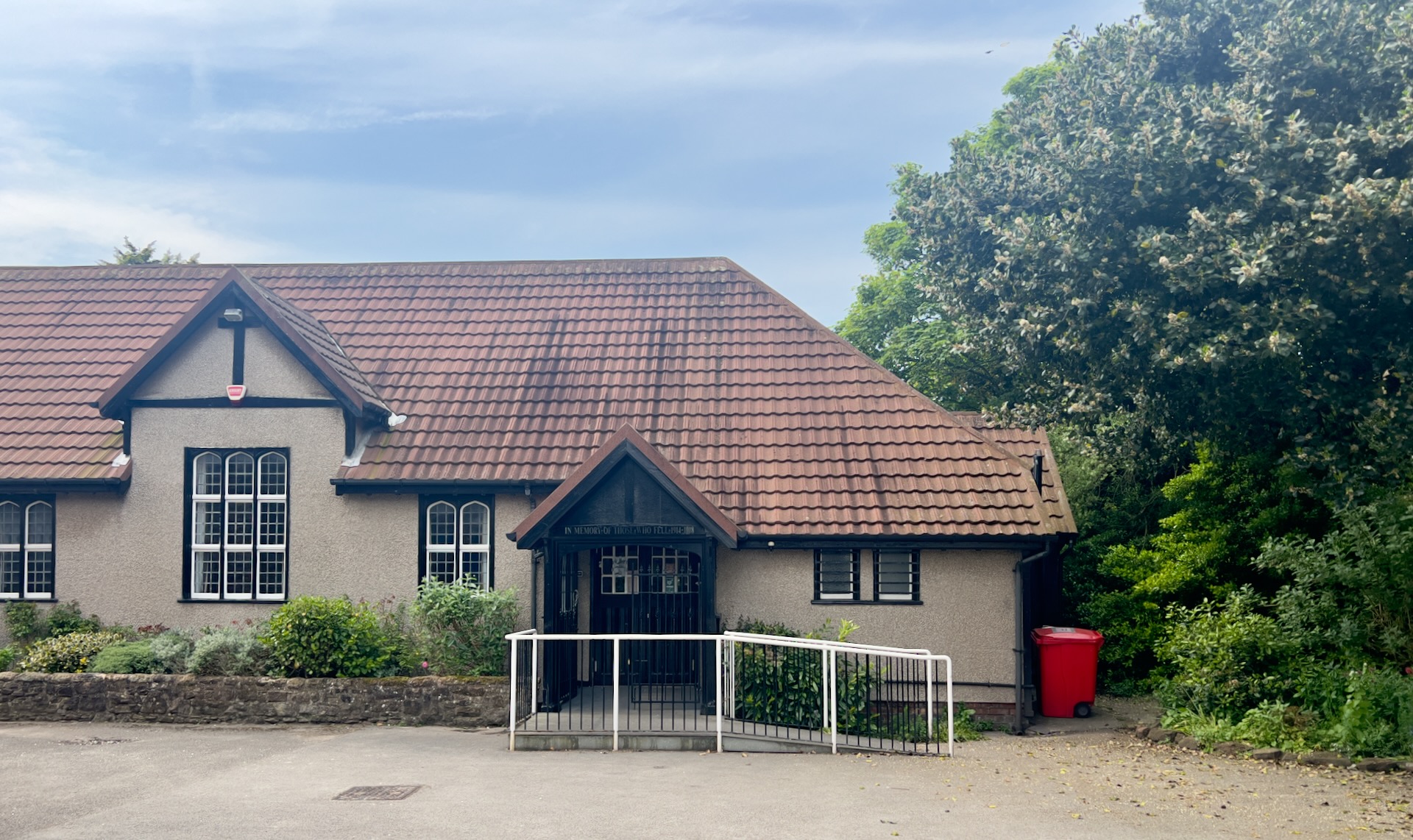
Of course Je t’aime was not much good for dancing, it was the smooching song played at the end of the night. The real staple of dancing was Motown, in fact Tamla Motown Chartbusters Volume 3 was practically a disco in it’s own right and used as such for house parties on a Dansette. The girls laid down their handbags and jackets and danced in a circle around them, a little club it was often difficult to break into. As a guy there was always a question, could you dance on your own? Sometimes the boys would form their own little circles, but they did not last long, after all you were supposed to be picking up girls. At some places it was OK to dance with a guy, but often you felt obliged to ask a girl for a dance, even though you might not fancy them at all. It was not deemed gay as such to dance with a guy, since that usage of the word did not yet exist for us, nor in reality did the concept. The insult was to be called a “homo”, but most people didn’t bother with that, they knew you just wanted to have some fun and enjoy the music.
The world of church hall discos expanded into sports clubs and eventually schools. Once you got in, sports clubs were cool since you could buy under age alcoholic drinks with no questions asked, while obviously at the church hall disco the staple drink was Cola. Some school discos were more like snogging contests, the dancing used as a polite introduction. Couples would then be seated all along the walls, french kissing for hours, forgetting the perfunctory disco. Dancing at the time was pretty basic and followed the sedate formula seen on Ready, Steady, Go and then Top of the Pops. Being a good dancer appeared to involve fancy footwork, as if we were all auditioning to be Irish dancers. Yep a few steps forward, a few back, what we would now call Dad Dancing. Occasionally for a rock song there would be a bit more animation from the guys, involving leaning over and shaking the head to and fro. If you were lucky a bit of jumping might be acceptable.
This was the situation at my first school disco, where I finally experienced proper rock music and managed to dance to it. The excitement was palpable when any of the following records were played: Summertime Blues by The Who, Paranoid by Black Sabbath and Black Night by Deep Purple. We felt we were experiencing the dawn of a new age, the search was on for “heavy” music, which was at the cutting edge of our adolescent experiences. This music belonged to us, our parents could not comprehend it. Near the end of that sweaty night, the lights suddenly came on, a Stanley knife had been found on the floor. There was often an undercurrent of violence at these dance venues, which you could put down to peer groups, nascent gangs or just the basic enmity between different schools. I avoided all this macho posturing as much as I could, but you had to be aware of when the trouble might start. My school did not hold another disco.
Another key dancing experience was at a Caravan Park in Woolacombe, Devon. For the first time I went on holiday with friends and not parents. As part of the provided entertainments there was a nightly disco, designed for families and bar regulars. The most popular song was Chirpy Chirpy Cheep Cheep by Middle of the Road, need one say more. However during the evening there was usually a Rock interlude, and then the 5 of us would take over the dancefloor, trying to outdo each other. There were no girls to dance with and we didn’t care, this was a celebration of youth culture and showing off. Hardly anybody else wanted to dance to these songs anyway, but we loved In My Own Time by Family, Devils Answer by Atomic Rooster and Won’t Get Fooled Again by The Who. After a few days we knew every word and electric chord and were jumping all over the place, fuelled by the local cider. I spent some time perfecting my split leg jumps to the power chords of Pete Townshend, it wasn’t easy to do that on time. The locals managed to put up with us, maybe we were deemed part of the entertainment. Of course, being under age, we couldn’t dance anywhere else.
Shortly after this the music scene was hit by T.Rextasy, all the girls seemed to love Marc Bolan. For a time T.Rex seemed to be all there was to dance to, and I did quite like Get It On and Hot Love. However it all seemed a bit retro and vapid, lacking in funk. At the time the Charts were a battleground, we all had our favourites, which helped define our personalities. At 6pm on a Sunday there was the Top 30 Chart Show on Radio 1, which was listened to in both horror and amazement, depending on who got to Number 1. Bizarrely it was followed by Sing Something Simple, as if to calm us all down. Over on television there was Top of the Pops on the following Thursday, where T.Rex had made their name with Marc wearing glitter and make-up. My most vivid memory of watching the show was the day my father declared the end of British civilisation while watching Sweet. Maybe he had missed the wondrous transgressions of David Bowie. Slowly TOTP seemed to become even more of a marketing exercise, with the real music appearing on Old Grey Whistle Test, where the groups actually played their own instruments, although there was less dancing on view.
And then came my Latin revolution. At the time I did not even realise I was listening to Latin music, it was all Rock to me of a particularly funky variety, with beautiful guitar playing. I am talking about Black Magic Woman/Gypsy Queen by Santana. I already knew and liked the original Fleetwood Mac version, but this was the song that started a new dancing style, my hips took on a life of their own. The break as they segue into Gypsy Queen and the tempo slowly increases was like a magic potion to me. I could certainly dance to this on my own, in fact usually had to, since I was behaving like some kind of whirling dervish. The first time was in Southport Rugby Club, surrounded by muscle men. Vague sense of danger, but I was kindly regarded as some kind of hippy loon. Only rarely was this record played in discos at the time, so you had to make the most of it. I believe I certainly made the most of it a few years later at a disco bar in Biarritz and upset the locals. Out of the blue I was punched to the dancefloor and received a good kicking, dancing can be a dangerous business. With shouts of pédé ringing in my ears, I hightailed it out of there, to be met with much tea and sympathy. I am still dancing to Latin music, but a bit more aware that the dancing style should match the situation.
Now all this is not exactly Idiot Dancing, that was yet to come. However I wrote the phrase “Bring Back Idiot Dancing” on my work folder around this time. I was already feeling I had missed the Sixties, that the craziness I had witnessed in the film Woodstock had disappeared and we were stuck in a kind of anodyne normalcy, behaviour could only go so far. I was proved wrong, yet by this time I had been to some exceptional rock concerts by The Who, The Rolling Stones and Led Zeppelin, but these were not dance events, there was no raving. At concerts you had to go right to the back to dance, you couldn’t dance properly in a packed, seated venue, let alone stand up. Of course at a good concert, you all jumped out of your chairs for the last song or encore and shimmied about, but you cannot call that proper dancing. Later at non-seated venues like Pathfoot at Stirling University I began to experience the mass psychosis and craziness that a thousand people raving together could bring on.
So now, for the time being, Rock became predominant. Everything else seemed lightweight, if not uncool. I was schooled by Darrell Jay’s Progressive Music Show at the Dixieland Showbar on Southport Pier, a huge ballroom. Here we preened to Rebel, Rebel by David Bowie, but eschewed the southern rock of Lynyrd Skynyrd. Can you dance to Be Bop Deluxe? Only with difficulty I found out. Meanwhile at Stirling University there was a free disco every night in the most amazing Student’s Union, The Grange. There was a bar, then some seats and tables alongside the DJ booth. In the middle of this large room there was a dancefloor, and then at the back, raised up and in the dark, sat all the dope dealers. Here the beer was 9d a pint or about £1 today (it was subsidised) and dope cookies were available on Tuesdays. So yes dancing nearly every night to all forms of rock known to man in 1973, as well as a fair bit of soul and then some plain weird stuff. The dancefloor was only about 5 metres wide and could become absolutely rammed, but anything went there. I learned how to dance in a confined space and still enjoy myself. I befriended the DJ’s to find out how they chose their music, but they were not very informative. Still in my second year I became the DJ Convenor for Stirling and managed the discos at Pathfoot, which would open a few days a week after the Grange closed at 10pm. We had 2 turntables, but usually no microphone. People could bellow in your ear for requests. The must play record was Alright Now by Free, not forgetting Brown Sugar by The Rolling Stones and Layla by Derek and the Dominos. I would try to slip in the heaviest song I knew, The Nile Song by Pink Floyd. However this was only available on the Relics album, side 2 track 4, and was very difficult to cue up in the darkness, so I often gave up. Also I would attempt to slip in a few tracks which I wanted to dance to, although vacating the DJ turntables was frowned upon. Silence was a sin. We danced to my selection of the hits, which I had a budget to choose and purchase every week.
Around this time I met Eric (and his pet rat), who was a big Northern Soul fan. Wow he could dance and in a totally new way, gliding around like a cool well oiled machine, none of that stomping and angular histrionics found in the student rock fan. I then discovered that people liked what they knew, and inserting a Northern Soul section into my playlist did not go down well with a writhing mass of drunken students at Pathfoot. This was old soul music and not regarded as cool, though on the other hand they loved It’s Better To Have (And Don’t Need) by Don Covay and demanded Superstition by Stevie Wonder. Not to be put off, I found some smooth leather soled shoes, which could allow you to swish around a wooden dancefloor, with your feet never leaving the ground. All the action became contained in the hips, incredibly fast and smooth. This was my home made version of the style used at Wigan Casino (without the dips), which I succeeded in trying out at the disco behind the Scarisbrick Hotel in Southport. However I soon found out this style did not work for Rock or on carpets, and I never plucked up the courage to go to Wigan Casino itself. There was also a high risk of ending up on your arse, if you got over excited.
Talking of gliding around, I did learn to waltz while working in France and it was wonderful. Well it was just one night, and the elderly teachers at the Lycée where I was working took me on board and taught some basic steps. Of course I was never leading, but by the end of the evening I was floating round the room, aided by some glasses of Crémant. It was never as good again. Everyone in France appeared to have gone to dance school, it was all Le Roc (a form of swing and jive dancing), there was no freeform or solo dancing. Eventually I approximated a clumsy form of this, using my waltz steps, but felt constrained and I constantly went off-piste, which did not go down well. What happened to the Rock revolution I wondered, it was like dancing in the 50s. I did not want to remember steps but to express myself. It felt like being one of the regimented souls on the original Come Dancing, which I despised. There was one fantastic night in Paris at a small sweaty club watching the crazy rock group Au Bonheur des Dames (like Sha Na Na meet Bonzo Dog Band) perform Oh Les Filles, the crowd intermingling and dancing like people possessed for the whole set, no sign of Le Roc, but plenty of hand holding, hip swinging, clapping and shouting. Magnifique!
Then came Punk, I cut my hair and loved the spirit, but you could hardly call it dance music, more like a mosh pit of anger and idiocy. You can only pogo up and down in one kinda way. As mosh pits go, Grannies in Cardiff with Stiff Little Fingers was pretty intense. Ian Curtis of Joy Division was certainly a mesmerising performer to watch, which I did at The Nashville Rooms in Kensington, but there were only a few tracks such as Transmission which I wanted to dance to. Soul music was the guilty pleasure of my Punk years. This was reinforced by going to see John Travolta in Saturday Night Fever, which I secretly loved and introduced me to K.C. and the Sunshine Band, but it was regarded as deeply unhip by my punk counterparts. The Disco wars had started and never the twain shall meet. That did not stop me from buying a Chic 12” on the same day as a 7” single by the Clash. I can fairly say that Shame by Evelyn ‘Champagne’ King is one heck of a record, but I might not have proclaimed that back in the day. I had missed the early records of Michael Jackson, but when I first heard Billie Jean it was electrifying. Down the empty disco I had no-one to dance with, so I ended up dancing with a pillar. Since then I have regularly used pillars as dancing partners, you can hang onto them or swing round, push away or nudge up to them. At a squeeze, walls can also provide a platform to bounce off or get close to, I love dancing with walls. If needs must, you understand.
There is a certain unwritten etiquette involved when you dance in public. Firstly you have to choose your space carefully, a favourite of mine was the gap in front of the speakers. If it’s too busy there try and carve out a space on the edge or in the shadows, which allows you to manoeuvre into a better position. Try not to come between couples or break into groups, unless invited. Once there, at least make an effort to synchronise your movements in some way or another, a lot of good dance moves are learnt by copying others. Lots of eye contact, respect all around and make clear your intentions. Sometimes I would dance with other people, at other times just on my own to get lost in the music. If there’s a pack of wild dancers down the front, head in and join them, it’s a communal activity after all, and give everyone the space they need as you interweave. Watch out for and avoid the flailing drunks, just move on if you feel uncomfortable. The worst mistake is standing on other people’s toes, always apologise. My biggest bugbear is people just standing there, not properly dancing, like some kind of bollard taking up valuable dancefoor space. Participate in those good times!
Falling out of love with the bombastic nature of Rock, it was African music that came to the rescue. The first real soukous music I heard was by Franco & T.P.O.K. Jazz, but it was his countryman Kanda Bango Man who I got to see and fell in love with. He appeared at WOMAD in the I.C.A, and the Africa Centre in Covent Garden, no seats there and room to dance. Nearly every song was an exhortation to dance, by the dynamic frontman. The revelation was the interweaving of the guitar line by Diblo Dibala, the very fluidity of his playing encouraging you to nearly ignore the rhythm and simply follow his swaying melodies raining down on you like an excited waterfall. Wikipedia says of Kanda Bongo Man “His form of soukous gave birth to the kwassa kwassa dance rhythm where the hips move back and forth while the hands move to follow the hips.” Reggae was also becoming popular, but that required a very laid back shuffle after a few blunts, not quite my animated style. Much more to my taste was Papa’s got a brand new Pigbag, an anarchic mix of tribal rhythms, James Brown bassline and funky jazz. I then tried Sol Y Sombra , a world music club in Charlotte Street, London, but it was all a bit fey and earnest dance wise, for me at least. The search was on.
Heaven. That was what proved me wrong. Heaven was a Cathedral of Dance, and probably still is. This is a gay club underneath the Arches at Charing Cross, London. The entrance is down an intimidating tunnel and to gain admittance you had to demonstrate you were gay, in which I falsely succeeded. Once inside there was a luxurious bar area and then the most cavernous dance hall I had ever seen. Not only that, the sound system was poundingly 3D loud, my bones were vibrating, while the lighting spread the length of the entire hall scanning and pulsating in time to the hi-energy music. The place was full of men, only men, frugging as if their life depended on the music, amazing dancers of all types. They carried on regardless all night, showing off their moves in a splendid array of S&M costumes. It was all bit much for little me, if not intimidating, but upstairs there was a chill-out bar with occasional live music where I could relax. This apparently was a superclub, I had never seen the like of it, dancing had arrived and was simply massive. All that came later (House, Raves, EDM) pales into insignificance with this first revelation, I have never been in a more amazing dance venue. I went back many times, saw friends performing upstairs, New Order downstairs, and my best man was the star of the first gay play performed there. I was also called out by a good gay friend for going there when I wasn’t gay, I didn’t care. Nevertheless I did not always feel at ease dancing there, it was all a bit motorik after a while, plus I was me on my own usually and felt a bit exposed, had to keep moving around, it was a predatory place. I was not part of the club, just a visitor. I remember going to The Fridge in Brixton and seeing Leigh Bowery, but he was a fashion icon rather than a dancer, plus I just wasn’t in the mood for dancing that night. Still, if you wanted to dance, gay clubs were the place to be in the early 80s.
There is no doubt who was the greatest idiot dancer. It was Jesus aka William Jellet, who really was an idiot, or at least severely misguided. Some of his quotes include “I never wanted to be Jesus, but I realised I was”; “Music has been used by God to open up people to find their true spiritual selves.”; “I’m completely free of the forces man has created, which stop him from being himself”; “If you want to know the truth, listen to Jimi Hendrix”. From the late sixties onwards and for many decades he would be the first man standing at a gig, his long blond hair waving over his kaftan (if he was wearing clothes that day), freaking out to the music in a sepulchral manner. He appears in several films of the period, including Cream’s last 1968 performance at The Albert Hall, The Stones in the Park in 1969 and the 1971 Glastonbury Fayre. One acquaintance said he told her that he loved Isadora Duncan and admired her for her free dance form, and that it was his bounden duty to dance. I first saw him at the Reading Festival in 1974 and forever after he would crop up at a huge variety of venues, even at punk gigs, although his preference appeared to be for the hippy era bands. He was often greeted with an ironic cheer when he stood up to start dancing, sometimes with maracas or bongos, and he was a regular at The Marquee in Wardour Street. For me he was an inspiration, the first man standing and you always felt he was behaving out of a sense of admiration for, and surrender to, the music. There is an excellent article about his life and crazy times by J.P. Robinson at Medium, from which these quotes are taken. There was also Stacia Blake, who danced with Hawkwind, but I think you would have to call her a professional, I presume she was paid. The same goes for Bez with Happy Mondays, a few decades later. Another public figure who I saw dancing like a dervish was Gareth Sager of Rip, Rig and Panic. This stands out since we were at an Ornette Coleman gig in the Victoria Theatre, Pimlico. Usually no-one dances at free jazz gigs, although this time there were two drummers and a pounding bassline from the album Dancing in your Head. It was a lesson that you could really dance to anything.
I may not be a trained dancer, but I did follow some movement courses. For nearly a year I had to move like an Orangutang every morning at 10am. This was part of theatre training at the Sherman Theatre, Cardiff, where I also learned some basic tumbles and acrobatics. These classes have stayed with me and certainly influenced my dancing. I also met my first professional dancers there, truly dedicated and fit people, even if they were always getting injured. They used to rehearse to the great roots album The Path by Ralph MacDonald, a percussionist influenced by both Trinidad and New York. It was at this time that Mike Bradwell of Hull Truck Theatre impressed me by saying his actors never went to the gym, but down the disco instead. Indeed, the BBC has stated that dancing is one of the best ways to reverse the ageing process. Years later I spent a good few years studying Tai Chi, I took those dexterous hand movements and incorporated them into my style, to the extent that I now dance a much speeded up version of that art form, with a bit of clapping included. I also worked with some professional dancers in theatrical and alternative productions. Again their work ethic was second to none, but they were useless down the disco, maybe it was too much like work. I saw Ballet Rambert in in 1976 doing proper modern dance, loved them. Later the seminal Michael Clark with The Fall at Sadlers Wells showed me how disparate art forms could work together, while my modern dance favourites were The Featherstonehaughs. The greatest dancer I ever saw was Louise Lecavalier of La La La Human Steps performing Human Sex in 1985 at The Town and Country Club, Kentish Town, London. Incredibly physical and acrobatic to a pounding, fractured live rock soundtrack. A thousand barrel rolls, a thousand swoops and swings, this was a work of unfettered abandon. Closer to home my flatmate was in Zoo, the hip TOTP follow up to Pan’s People, now he could dance and do the dips, great fun! My dance style is the culmination of all these influences, I hope.
It is important to remember why I was going out to these clubs. As opposed to most of my friends, I was not trying to pick anyone up, get drunk or score drugs, though that may have happened. If there was no dancing, or I just stood watching, the evening was a disappointment. Many a time at a party I retreated into a corner and started dancing with myself. There would be no dancing if I didn’t like the music, I was strict about that, but as you have seen I would dance to nearly anything. Sometimes though I just wasn’t inspired, you had to feel the music begin to pulse through you, get ready for take-off, then make your move. At other times the music was so funky I just had to start the dancing, get the party started. Dancing is like a virus, someone has to get infected. These were often the best moments, you had to find your style for that moment, be totally engaged, prove the validity of the music. And of course one was on show, so you did your best in the circumstances. Too much flailing or being too fast would put off the other dancers, this had to measured, you were aiming for mass participation. I often failed.
There are many ways to dance to songs and sometimes it is the very words which become the expressive root. I was in a small back street bar in Antiparos, Greece called The Doors. As the night progressed tables were cleared and the tiny floor became a writhing mess of bodies, with people also perched on the bar and chairs, shaking along to the music. As expressed by the name, this was a rock venue, and unexpectedly the highpoint was Hurricane by Bob Dylan. This is not a dance song, but a story song, and the words became the source of the movement. I knew every word and proceeded to act them out, howling the key lines along with Bob. A similar experience happened with Born to Run by Bruce Springsteen at The Boogaloo on Archway Road in London. The very intonations of the words can provide the rhythm for dance. It is your choice what aspect of a song to dance to, usually it is the percussion, sometimes the bassline. If a song feels a bit slow pick out the tambourine or congas, they are often at double tempo. The problem with a lot of electronic dance music it that it mandates the rhythm, you are locked in with no real variation for minutes on end, I soon get bored. Dancing should be dynamic, not formulaic.
This is a description of my behaviour at a jazz venue, Cafe Oto for example. I am sitting down because that’s what you do. I still can’t believe how static people are listening to live music. I know some people don’t like to dance, in particularly many of my musician friends, yet I get a strong physical reaction necessitating movement. The music plays, light rhythm, singer songwriter on electric guitar with cool amplified foot beat. The audience sit there like Easter Island statues, kinda riveted and not moving. Out of the corner of my eye I see a lady holding a glass. There is one finger tapping it. I am a mess of subdued kinetic movement. Right now my head is sharply flicking maybe five degrees every few seconds, mainly to the left. My arse is constantly shifting weight in time to the music, the muscles there causing a rolling motion in my torso. The shoulders too are rolling, moving back and forth about one to two centimetres. Legs currently stationary, being careful with a bottle under the chair. All quite contained. I look around again, no one is moving. A few minutes later I have shifted position and my legs are at about 90 bpm, bouncing on the toes. My head has calmed down. No one else is moving. Are we listening to the same music? Why am I the only person moving?
Maybe after that I should provide a little list of my own great dance experiences, although you have to imagine them since talking about dancing is even worse than trying to describe music. OK, dancing barefoot on hessian mats to the Ace Records soul extravaganza (featuring Jimmy McCracklin), feet a mass of blisters the following day and I could hardly walk. Dancing calypso with a Prime Minister, Maurice Bishop of Grenada, cruelly assassinated a few years later. On La Isla Bonita with squaddies in Belize, quite competitive. In China dancing solo in a an empty venue the size of Camden Palace with a 16 piece band – just to show them how it’s done. Down Philip Sallon’s Mud Club, in various London venues, all of a haze now. Standing on the chairs at the Royal Festival Hall as the crowd erupts over Khaled, all night. The Tropicana Beach Club, off Drury Lane, non stop samba party, and what a great dance club! Freaking out to The Hives at the back of The Roundhouse. The bass speakers at Cargo in Hackney going right through me, giving me palpitations. Bukky Leo at Passing Clouds in Dalston, packed full of Fela Kuti rhythms. The Big Chill and Womad festivals, too many events to remember. Most recently at a Disco Soul night in Hornsey Town Hall, for maybe the last time. Lots of kudos from the young people that evening. Many a time I have been asked what drugs I am on, or whether I have some to sell. The answer is always “Nothing. I am high on the music, Thank You”.
When I say Idiot dancing, I am referring to a totally freeform type of movement in response to the music. It can be of any style, but energised with a sense of wildness, even danger. I love kinetic performers, reacting to their music. The best recent example is Samuel T. Herring of Future Islands dancing to Seasons (Waiting On You), as seen on the Jools Holland TV programme. I dashed out and bought the record, trying to incorporate some of his moves into my own style. Another revelation was Beyoncé on her first solo hit Crazy In Love, that performance turned her into a star, every word actuated with movement. Certain records instantly make me want to dance, for many years the best was Boogie Wonderland by Earth, Wind and Fire, at other times Finally by Ce Ce Peniston or Too Blind To See It by Kym Sims. A certain record can just click into place, it consumes you, you forget yourself and life can’t get better. This has happened dancing to Step It Up by the Stereo MC’s, My Baby Just Cares for Me by Nina Simone and You Get What You Give by New Radicals. You have to get involved to get the feeling, the unexpected are often the best, trust the DJ and follow his lead. “Enjoy this trip and it is a trip” said S-Express on one of the craziest and most stupid dance records ever, a glorious meaningless wind-up. It has all calmed down a bit these days, so to conclude on an elegiac note here is a quote from the album Record – Nine euphoric feminist bangers from Tracey Thorn – or so says the sticker.
Dancefloor by Tracey Thorn (2018)
Play me Good Times, Shame
Golden Years, let the music play
It’s where i’d like to be
Is on a dancefloor with some drinks inside of me
Oh it’s where i’d like to be
*
This is a list of the issues confronting the cyclist in London. In theory we are supposed to be enjoying a new government push to encourage cycling. New cycle lanes and bike superhighways are being built, some of which are excellent. However many of them simply end at the roundabout or busy junction, they are hard to find and badly signposted. In addition scant respect is paid to cycle lanes by drivers, often ignoring or parking in them, while the bike box at traffic lights is regularly full of cars.
Well, obviously first on the list are potholes. Here are three in a row. On their own they are dangerous enough, causing hospital visits by simply throwing people off their bikes. Combined with the dangers of traffic, you are often forced to take evasive action confusing other road users who will not be looking at the parlous state of the road.
In this example you are forced to cycle in the middle of the road, competing with traffic accelerating away from the traffic lights. PS: Hole is even bigger now!
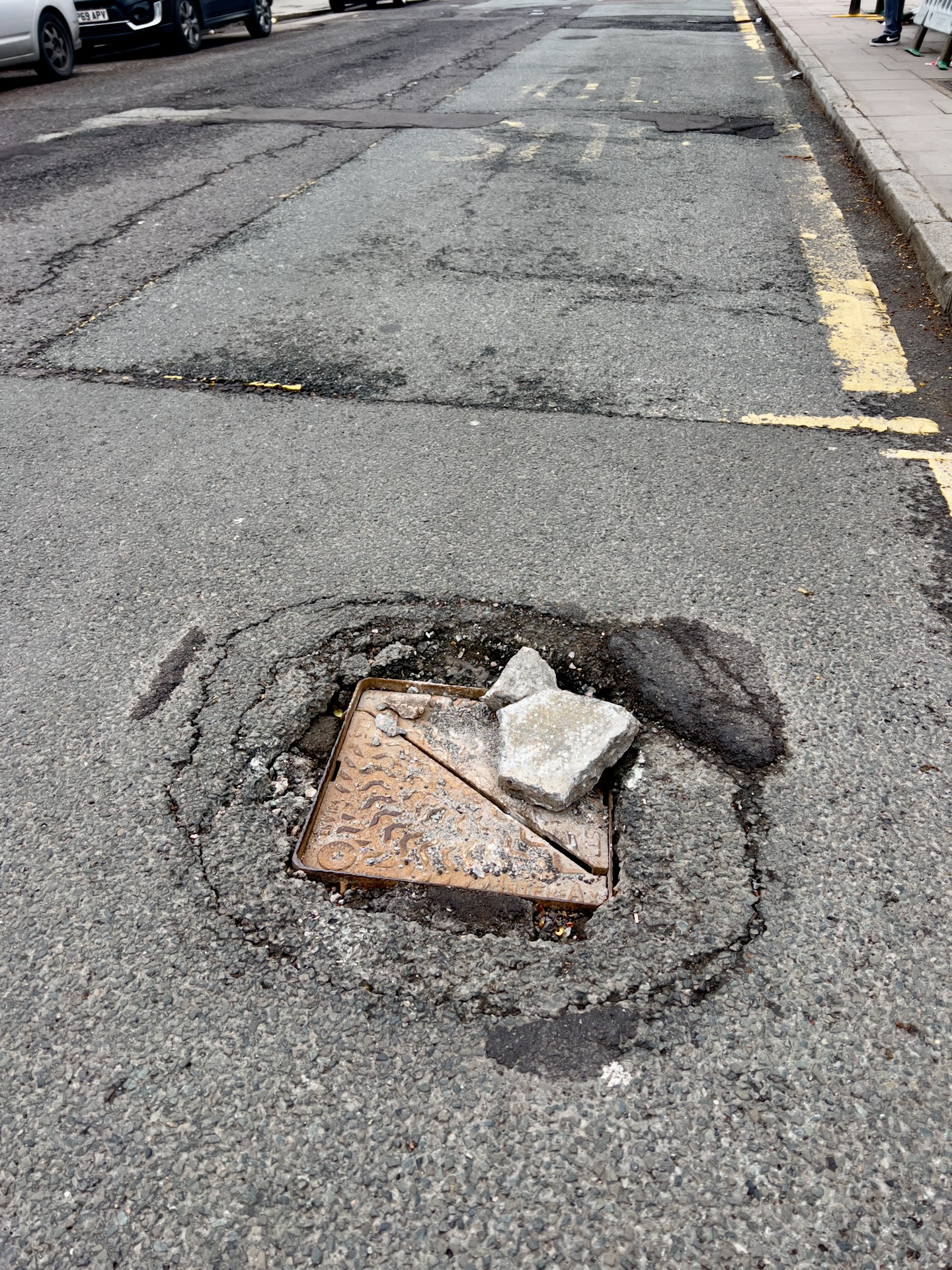
Same A Road a year later – complete leg breaker!
This is a particular bugbear of mine. Sometimes the road narrows because of roadworks, which can often drag on for months. Recently they are often building bike lanes, but during construction the cyclist often has nowhere to go, endangering themselves and other road users. Yet often the road appears to narrow by design, either as a traffic calming measure or to aid pedestrians. On a busy road these are a disaster waiting to happen, we are suddenly much too close to buses and heavy lorries, often feeling forced to pull out in front of them, hoping we get noticed. Below is a classic example in my local high street, they are supposed to be making wider pavements for social distancing.
This A Road will soon be a liability for cyclists.
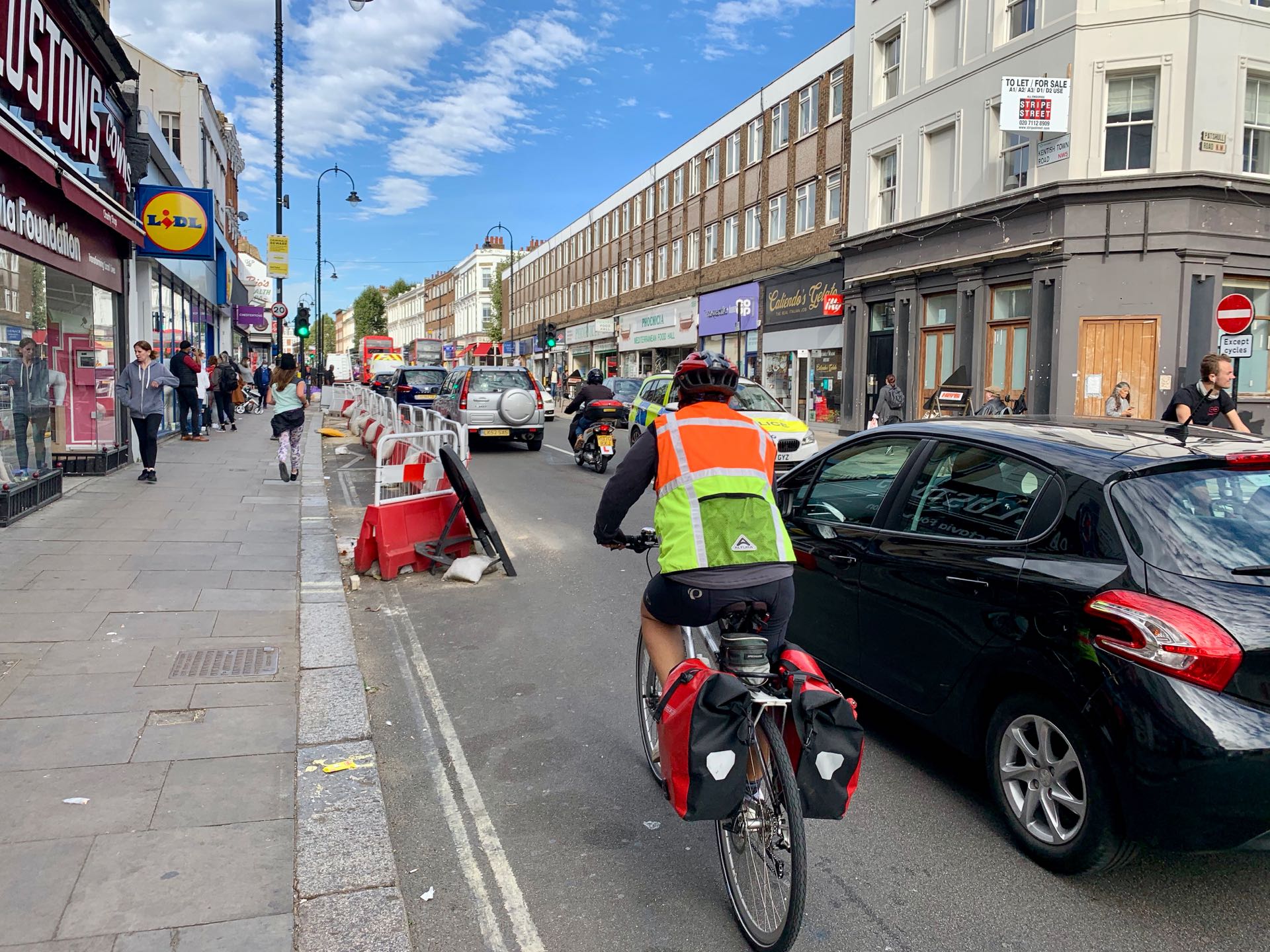 Is there room to get through? Who takes priority? Dangerous decisions forced upon cyclists by narrowing the road.
Is there room to get through? Who takes priority? Dangerous decisions forced upon cyclists by narrowing the road.
I understand the reasoning behind sleeping policemen, they are to slow the traffic. However when the speed limit in Camden and Islington is usually 20mph, how much slower can you go? In addition they appear to be some kind of work creation scheme, 1 or 2 is never enough, they sprout everywhere. Why on earth are there so many on bus routes?
For the cyclist they may be annoying, but some are so badly conceived and made that I find them plain dangerous.
In this example the camber to the gutter is simply too much, you are forced to ride at least a foot away from the pavement on a busy and narrow road.
Perhaps keeping the yellow line was more important than safety.
Yes I have done it, that is skidded on the metal street furniture that infests our roads. I now avoid them assiduously, however on busy roads that is not always possible. In wet or icy conditions these metal plates are particularly dangerous, please no braking or turning while bumping over them.
I hope to post a better example of one placed bang in the middle of a right hand turn.
If they exist, signposts for cyclists are confusing and way too small. Why are they blue like motorway signs? Signs are important for all road users, we should not have to stop in order to read them. Many “signs” for cyclists are placed on the road and soon deteriorate. There needs to be a national signage for cyclists campaign.
In this example the sign is just plain wrong. The road is NOT No Entry for cyclists, it has a bicycle lane.
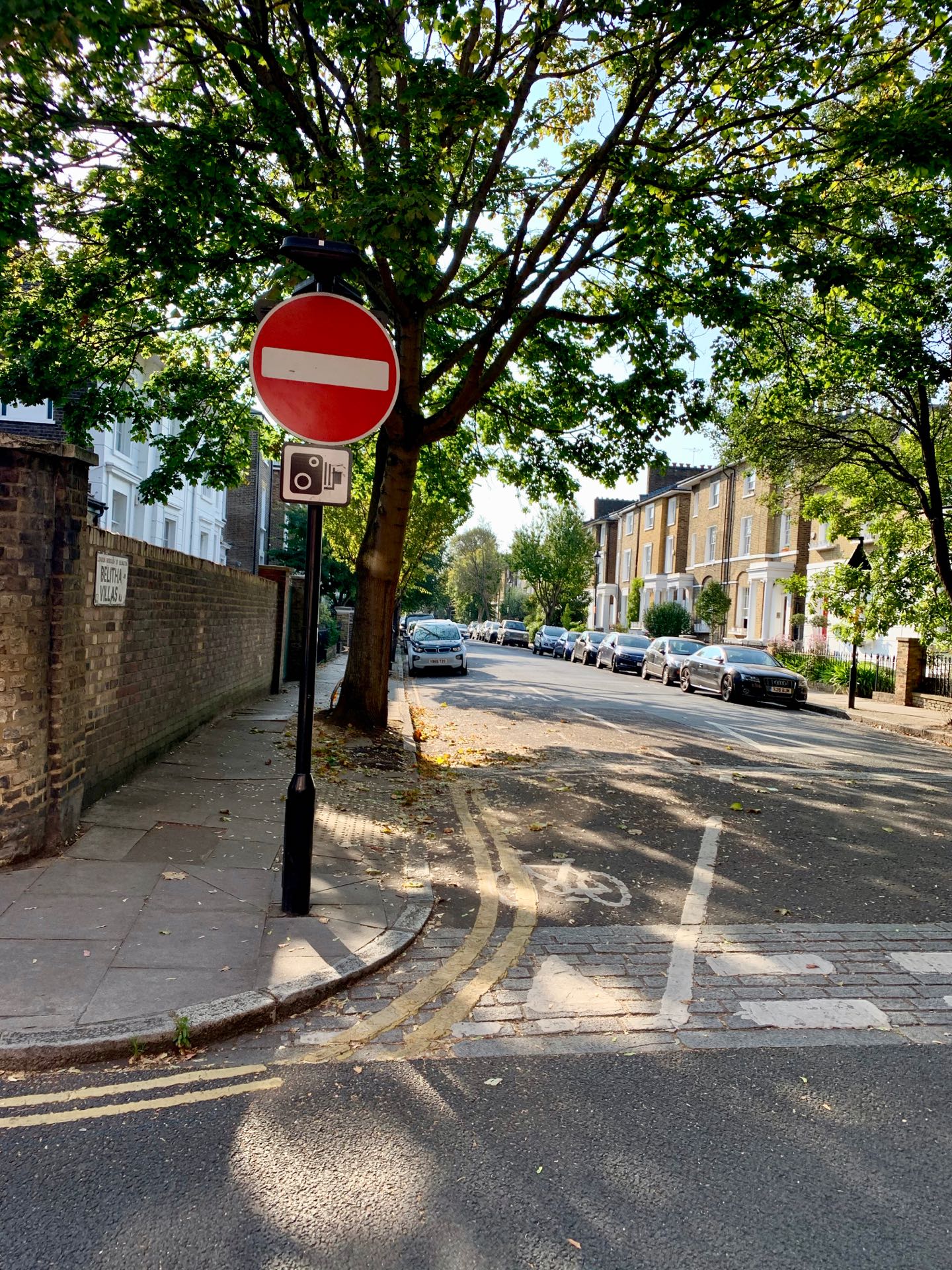 The intimidating camera sign should of course say “Except for Cyclists”.
The intimidating camera sign should of course say “Except for Cyclists”.
Crying Wolf
This temporary sign is an insult. It is supposed to tell cyclists to slow down, because they are outside a school. However since the school is closed, like on this Sunday, it should not be there. This sign is fake news, there is no reason whatsoever to slow down. The more fake signs there are just encourages cyclists to ignore all signs. Stop crying Wolf !
Bollard in the Road
What is this black bollard doing here? It appears to be of no practical use, but is particularly dangerous to cyclists, especially at night. Surrounding the bollard are 8 confusing signs, distracting the cyclist. The bollard is completely black, nothing reflective, it simply disappears at night. Remove this dangerous piece of useless road furniture now!
These are just a few examples from my local area, which I hope to add to in the near future. Happy Cycling!
*
Article featured in Nikon Rumors June 15th 2019
Comments included:
– That’s a very good article. If a D5xxx works for you, that’s great.
– This is a good article for enthusiasts to read and feel confident they are justified in buying and enjoying a DX system.
I am often asked for camera recommendations and my standard reply is the Nikon D5500. The later D5600 is basically the same camera with Snapbridge (an app for phones), which I never use. To make this into a “Pro“ camera I suggest attaching some some full frame FX lenses, which will give you startling sharpness, very little vignetting and no corner fuzziness. You are just using the best part of the lens, which is basically over-engineered for usage on DX crop sensor cameras. Take a look at nearly all MTF charts and you are avoiding the wavy (not as sharp) part of the graph on the right hand side, which is the edge of the sensor.
Here is the Nikon MTF Chart for their AF-S Nikkor 50mm f/1.8G full frame lens.
On a DX camera you are only using the lens up to the vertical dotted line.
A note about terminology.
A DX or APS-C camera is a so called crop sensor camera, meaning the the sensor is 1.5x smaller than a full frame FX camera. The sensor in a full frame camera is 24x36mm, the same as classic 35mm film. Thus on a crop DX camera the standard 50mm lens becomes a 75mm lens (50×1.5=75), a short telephoto. DX lenses cannot normally be used on full frame FX cameras, the image does not cover the whole sensor. On a DX camera a standard lens would be a 35mm, giving roughly the same angle of view as a 50mm lens on full frame. The Nikon 18-55mm DX kit lens is equivalent to a 27-82mm full frame lens.
The sensor in the D5500 is 24.2 mega-pixels, which is the same resolution as many full frame cameras such as the Nikon Z6 or D750 and the Sony A7.
My favourite lens combination in this regard is the AF-S Nikkor 50mm f/1.8G. You might think a full frame lens would be too big on a DX camera, but it fits perfectly in the hand and weighs less (185g) than the 35mm DX f1.8 lens (200g), specifically made for crop sensor cameras. Best of all it does not look like a telephoto lens, has well recessed glass and focuses down to to 0.45m, very good for a 75mm lens. It is no wonder Nikon do not make a DX 50mm lens, it would be pointless to try and improve on this. In crowded social situations this focal length is ideal for picking out faces in the melee, and is several centimetres shorter than the kit zoom lens which is only f5.6 at 50mm. Indoors with average room lighting that will never be fast enough even at ISO 3200, and of course you lose the the 3D effect of an f1.8 lens.
At events when I am a bit further away I use the AF-S Nikkor 85mm f/1.8G, which becomes a very fast 130mm lens on DX. This extremely sharp lens sits well on the D5500 and only weighs 350g. Another FX lens I have used extensively is the tiny Fisheye Nikkor 16mm f2.8, which requires manual focusing, but does give a unique picture angle of over 100 degrees. For general travel and video usage the AF-S Nikkor 24-120mm f/4G VR lens is much heavier, but still quite manageable and becomes a powerful 36-180 lens without any FX corner fuzziness.
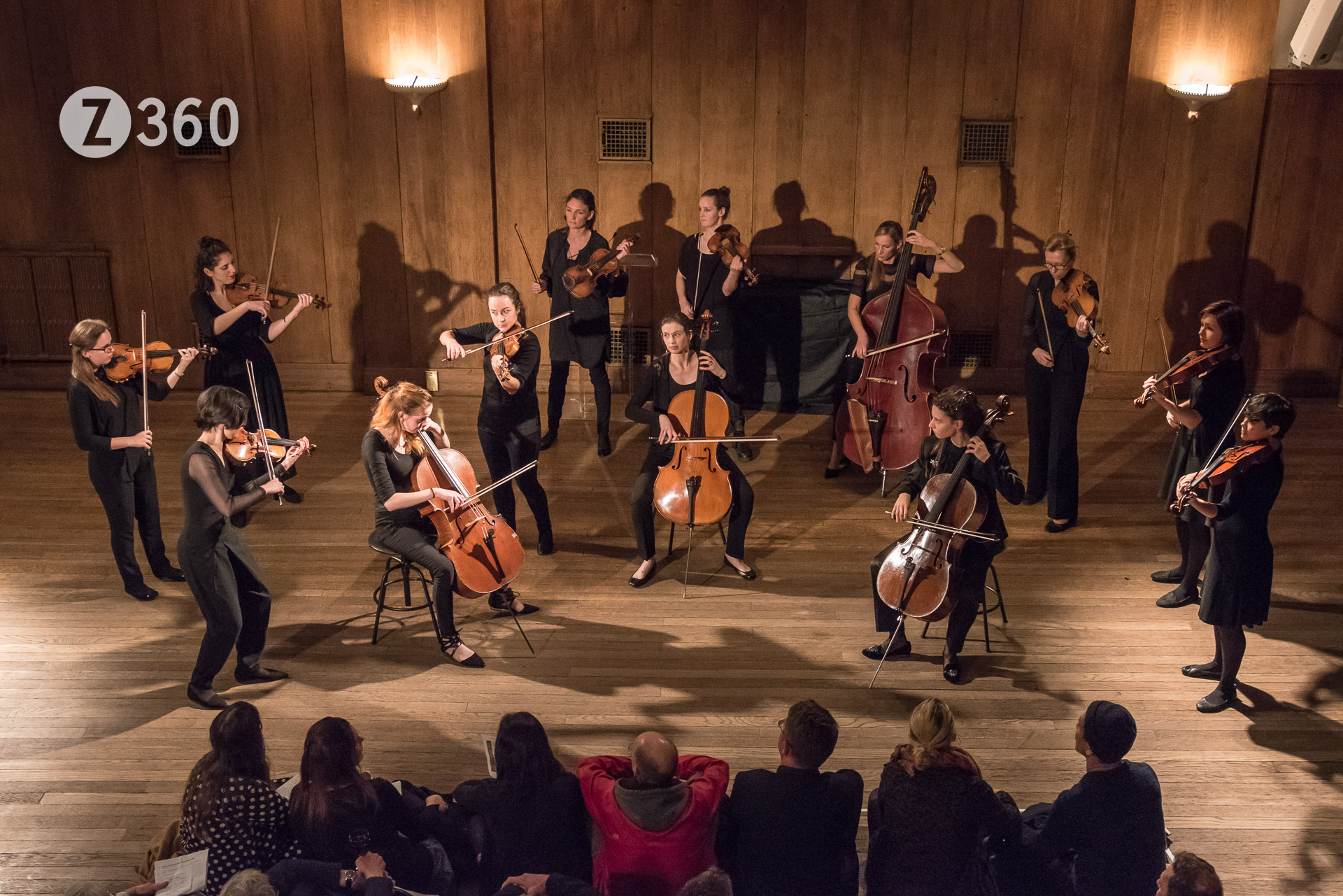
John Landor Music in Motion at Conway Hall, Holborn
AF-S NIKKOR 24-120mm f/4G – 1/125sec, f4.0, ISO3200
To put all this in perspective the D5500 is a remarkably light camera (470g) with an excellent grip. While lacking a few bells and whistles, in particularly a discrete aperture dial, you soon get used to this and I have yet to find something the camera can’t do once you are familiar with the menus. The touch screen is also remarkably useful and can be used to set focus. It competes well with mirrorless cameras, being smaller and much lighter than a Nikon Z6 or Sony A7, and while the Fujifilm X-T30 may be a little smaller it does not have a proper grip and is at least twice the price. I prefer to handhold my camera and do not use a strap, which inevitably gets in the way and makes shooting less flexible. If you really want a light camera choose a Nikon D3500 which only weighs 365g, the lightest DSLR ever. It is the same basic design as the D5500 with the same sensor, but has only 11 AF points, as opposed to 39 on the D5500. I would not recommend it for video since it has no flip out screen or headphone/microphone port. It does represent excellent value, the results for stills should be as good as cameras costing four times as much.
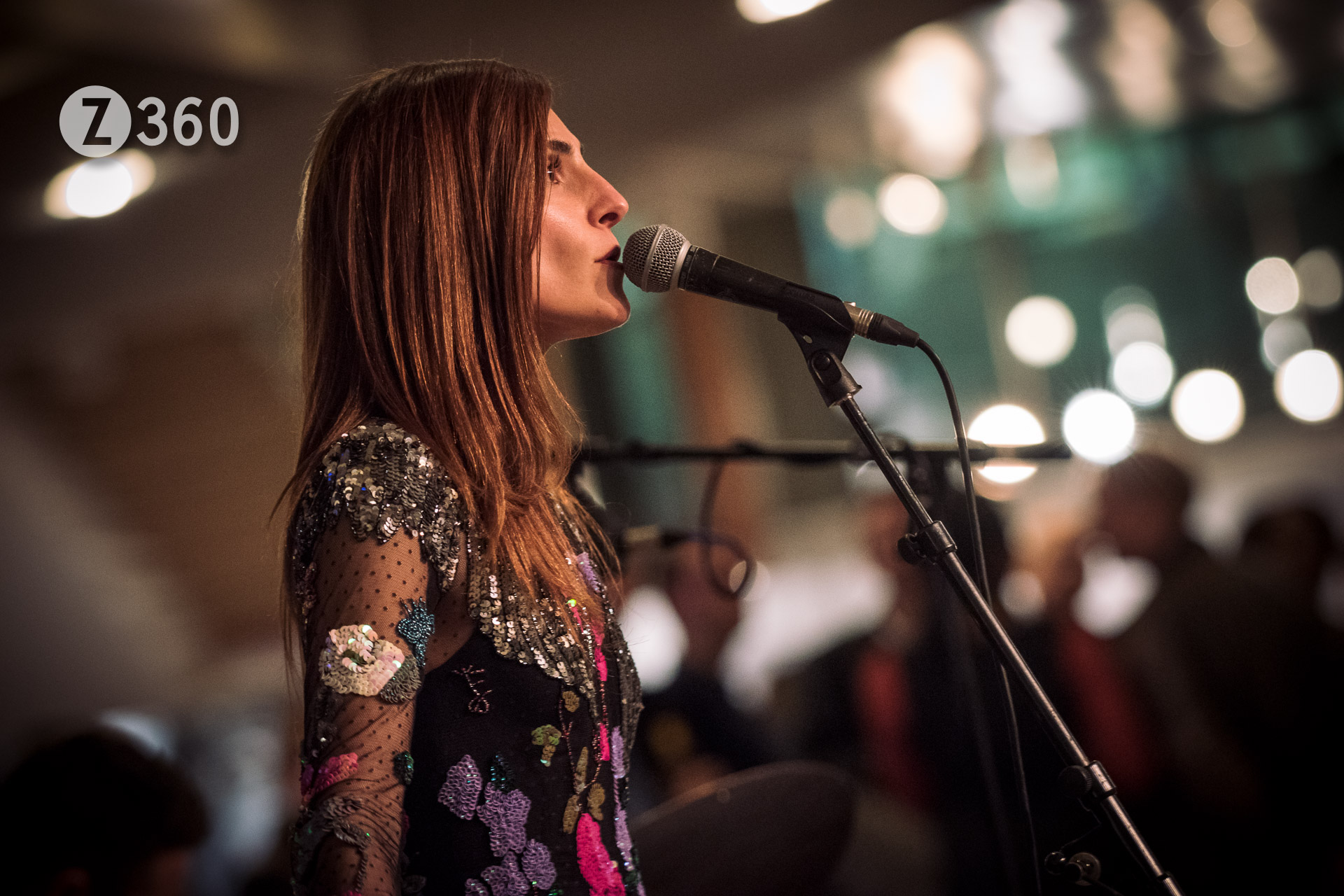
Irene Serra at Royal Festival Hall, Waterloo
AF-S VR NIKKOR 70-200mm f/2.8G – 1/200sec, f2.8, ISO2500
So to conclude my bargain camera would be a Nikon D5500 with 18-55 kit lens, currently available for £450. If you never use video and want to save more money try a Nikon D3500 with kit lens, about £315. The kit lens is usually heavily subsidised, you might as well purchase it since it is the only way to get a cheap wide angle on DX cameras, and they perform well enough these days. Next stop is the 50mm lens, which you can find for £150, or less second hand. If buying older lenses remember only the post 2000 G or E lenses with no aperture ring will autofocus on these cameras.
All pictures were taken as Raw files and processed in Adobe Lightroom.
Here are some more examples of full frame lenses on the D5500:
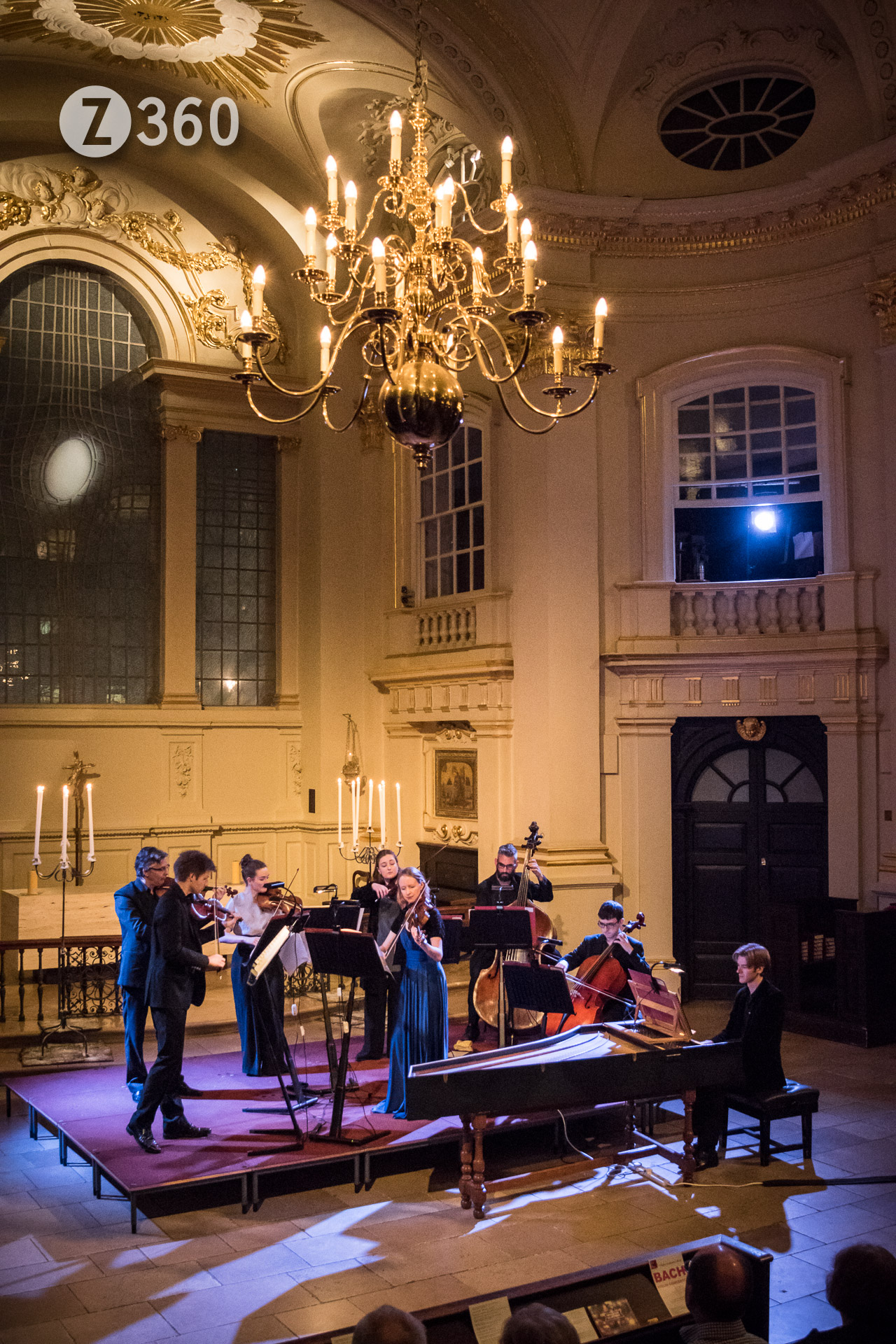
John Landor Bach Recital at St Martin-in-the-Fields, Charing Cross
AF-S NIKKOR 24-120mm f/4G – 1/125sec, f4.0, ISO3200
All Photographs ©Douglas Cape z360.com
My current attempt to be an author is now online
This is a first draft, with lots of pictures
It is a true story about hitchhiking across America and Canada in 1976
Any comments appreciated
PS. May not be online for long
This cover shoot in 1985 was the apotheosis of my burgeoning photographic career. From the early 70s I read the New Musical Express religiously every week and even completed the crossword. Meanwhile The Smiths had become my favourite indie group, so the combination was everything I had ever wished for, this was as good as it got.
Commissioned by Tony Stewart the deputy editor (who I later unfortunately followed to the ailing Sounds) I drove the journalist Danny Kelly up to The Hacienda in Manchester where the shoot took place. I had done a fair amount of preparation, constructing a halo from a fluorescent ring lamp and preparing some gory make-up. I had no assistant and did all the set-up and prosthetics myself. Morrissey was as sweet as pie and liked the idea of the stigmata. He only balked when I wanted to use the actual club for some background shots, saying that he’d already been photographed there. Still it all went very well, but I wasn’t allowed to attend his interview with Danny and spent several hours hanging around the gothic Midland Hotel.
The shot chosen for the cover was not my favourite, but I guess it fitted their layout best. They did use a classic black and white shot with the interview, later featured on the cover of Morrissey: Fandom, Representations and Identities.
Back in the 70s the New Musical Express was a wide church, encompassing all contemporary music including folk, jazz and even modern classical. I discovered Philip Glass, Jan Garbarek and the Art Ensemble of Chicago in their pages. They would feature campaigning articles about Red Wedge and occasional specials such as a Youth Suicide issue. The writing was varied, iconoclastic and opinionated, notable favourites being Richard Williams, Barney Hoskyns, Ian Penman, Nick Kent, Tony Parsons and even Charles Shaar Murray. By turns humorous and political the NME became the voice of alternative youth, there was no-one else with their finger on the pulse. In addition they produced a series of budget cassettes starting with C81, which championed their diverse musical influences.
The NME slowly headed into a dead end street of their own making, forgetting their history and the wilder shores of music practice. The writing lost all ambition and pretension, there was only so much you could say about guitar bands amid the narrow confines of Britpop. In the 70s you read the NME to discover new music and new attitudes, not to catch up on the gossip in the Sun’s Bizarre column. The world still needs a daring and authoritative music magazine, there is The Wire, but what do they know about pop music?
R.I.P. NME ‡
I am writing this In Memoriam to Jazz at The Oxford, my local jazz club in Kentish Town, London. It happened on a Monday (when nothing happens) upstairs at a local pub for 12 years and was like having Ronnie Scott’s just down the road, but much cheaper, more relaxed and more personal. It was run by George Crowley, an excellent saxophonist in his own right, often playing with the guests and of course when the guests couldn’t make it.
While it started off as often too full of student alumni, it only cost £5 and every so often someone of the calibre of Shabaka Hutchings would turn up. Great nights included someone transporting a full size Hammond organ up the stairs, big bands such as Crocodile outnumbering the audience and of course musicians of the quality of Jeff Williams, Laura Jurd, Martyn Speake and Kit Downes. I will be missing this…on occasional Fridays some of these musicians may appear at the Con Cellar Bar aka The Constitution on the canal in Camden.
Meanwhile the amazing Cafe Oto in Dalston, now the UK home of Sun Ra, continues to plough its unique furrow through nearly any kind of modern music as inspired by Wire magazine. A staggering number of amazing concerts with the cream of British avant garde jazz as well as luminaries from many international genres.
The sackcloth backdrop which looks like a temporary rebuilding memento is still there as is the relaxed and concentrated vibe which draws in performers as varied as The Necks, Annette Peacock, Jimi Tenor, Marc Ribot and The Thing. There is no stage, we are one. Just so you know – I’m a Member!
Across the road is one of London’s most famous and established jazz clubs, The Vortex.
While presenting an excellent cross section of soul and avant garde jazz, I have always found the room a little bit too concrete and dry after it moved from its original location, a funky, wooden and crazy place in Stoke Newington Church Street, which for a few years until 2004 was definitely the best jazz venue in London. Thank you Billy Jenkins for some great nights there. Also of note is the funky Servant Jazz Quarters round the corner. Meanwhile just south of the River, an important new improvised venue opened recently called iklectik, set in hidden arty gardens in Lambeth and I would recommend discovering the Horse Party. Just don’t tell the Archbishop.
This article is also inspired by a recent visit to the venerable Jazz Cafe, just off Camden High Street. After becoming one of the key venues for New British Jazz in the late 80s, the tiny L shaped wine bar in Stoke Newington Green expanded to a large venue in Camden and has recently been refurbished as a full on night club, featuring jazz. The main floor is open with a restaurant of sorts on the balcony and this works well for funkier outfits, such as Bill Evans who I saw there only this week. Seen some great gigs here such as the Paul Motion Trio (see above), Nils Petter Molvaer and Pharaoh Saunders.
Talking of L shaped rooms the L in the Flim Flam venue at Ryans Bar, again in Stoke Newington Church Street, has been removed after refurbishment. This venue is run by Alan Wilkinson, a free sax improviser of long standing and on Wednesdays presents the best of improvised music with an eclectic lineup of the famous and crazy in nearly equal measures.
For more varied musical fare there is the Fiddlers Elbow just outside the Camden Market tourist trap area, presenting live music every night. The main pub room is kinda pentagonal, with a dance floor.
A mention for a few others such as the 606 in Chelsea, allegedly a members supper club, but which presents British jazz and soul in an atmospheric candle-lit cellar. In Soho there is Pizza Express and of course the famous Ronnie Scott’s, both also a bit supper club these days. Ronnie’s does attract some outstanding acts, often American, due to being established over 50 years ago by a very funny and excellent saxophone player. Great nights here have included Art Pepper, Airto, Stacey Kent and of course Nina Simone. Also recommended in Central London is the celebrated 100 Club in Oxford Street, still surviving after many years. Vividly remember gurning at Slim Gaillard here for a couple of hours and grooving to the late Tommy Chase Quartet.
A good standby in town is the Ain’t Nothin But Blues Bar in Kingly Street, which does what it says on the tin 7 nights a week. Further East is the Village Underground, a cavernous venue under huge railway arches for Shoreditch hipsters who don’t like sitting down. Primarily a dance/pop venue it occasionally features jazz acts such as Snarky Puppy. The nearby Rich Mix in Bethnal Green has a more varied World music programme, but I am pleased to see James Blood Ulmer is appearing there soon, last seen at Cafe Oto.
Finally a big favourite is Boat-Ting, allegedly London’s hottest new music and poetry club, although after 14 years it’s not that new. Hosted by livewire Sybil Madrigal it regularly features NEW – with Britains best drummer, Steve Noble, powerhouse double bassist John Edwards and the virtuoso guitarist Alex Ward. Best of all this is a jazz club on a boat on the Thames, feel the waves like nowhere else..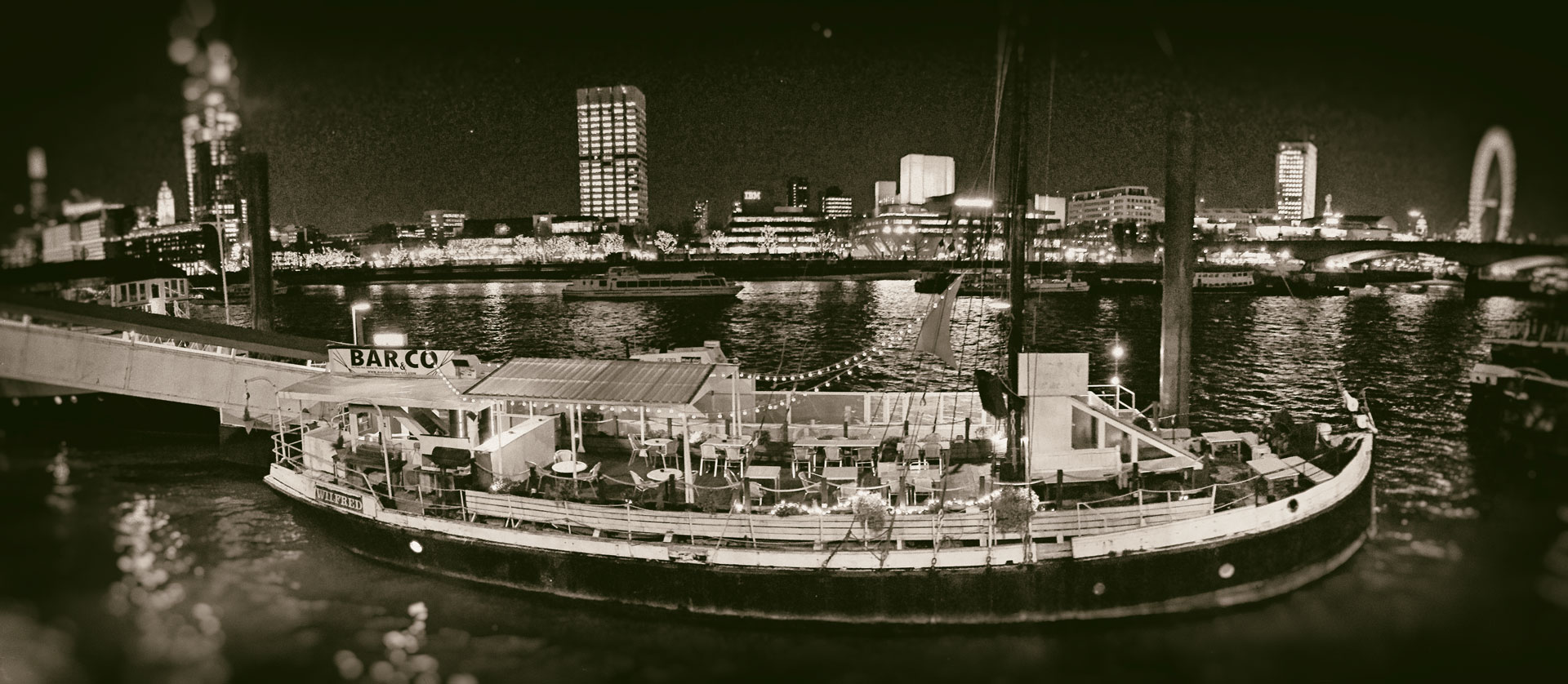
So where else in the world could I stand 3 feet away from a world class musician on a regular basis? Answers on a postcard, maybe from New York.
Nearly all these places are dirty, cheap, relaxed, and half full some of the time.
You can find some more proper pics of some of these places at Z360 Live Music
Flim Flam, Ryans Bar Stoke Newington
Boat-Ting, Embankment The Thames
R.I.P. The Bull and Gate, Kentish Town. The Spitz, Spitalfields. The 12 Bar Club, Tin Pan Alley Denmark Street. The Red Rose, Finsbury Park. The Adelaide, Belsize Park. The Mean Fiddler, Harlesden. The original Marquee, Wardour Street Soho. The Moonlight aka Klooks Kleek, West Hampstead.
And don’t forget The Klinker wherever it is…
Update February 2019
Jazz is now back on upstairs at The Oxford, Kentish Town. George Crowley is no longer running the evening, but he was featured there recently and it was a great pleasure to see him destroying the “standard” he was requested to play.
This scrolling music player will automatically scroll when the cursor is placed on the right (or left) hand side, and will pause with the cursor in the centre.
The speed is relative to the cursor placement and can be finely controlled.
Requires Flash for full control, but will play in HTML5 without auto scroll.
Right click or control click for a proper fullscreen experience.
To stop any jerkiness play through entire score before usage.
~
This Player was developed in conjunction with the Conductor John Landor. You can see it being used here at a rehearsal in St Martin Kentish Town, Gospel Oak, London.
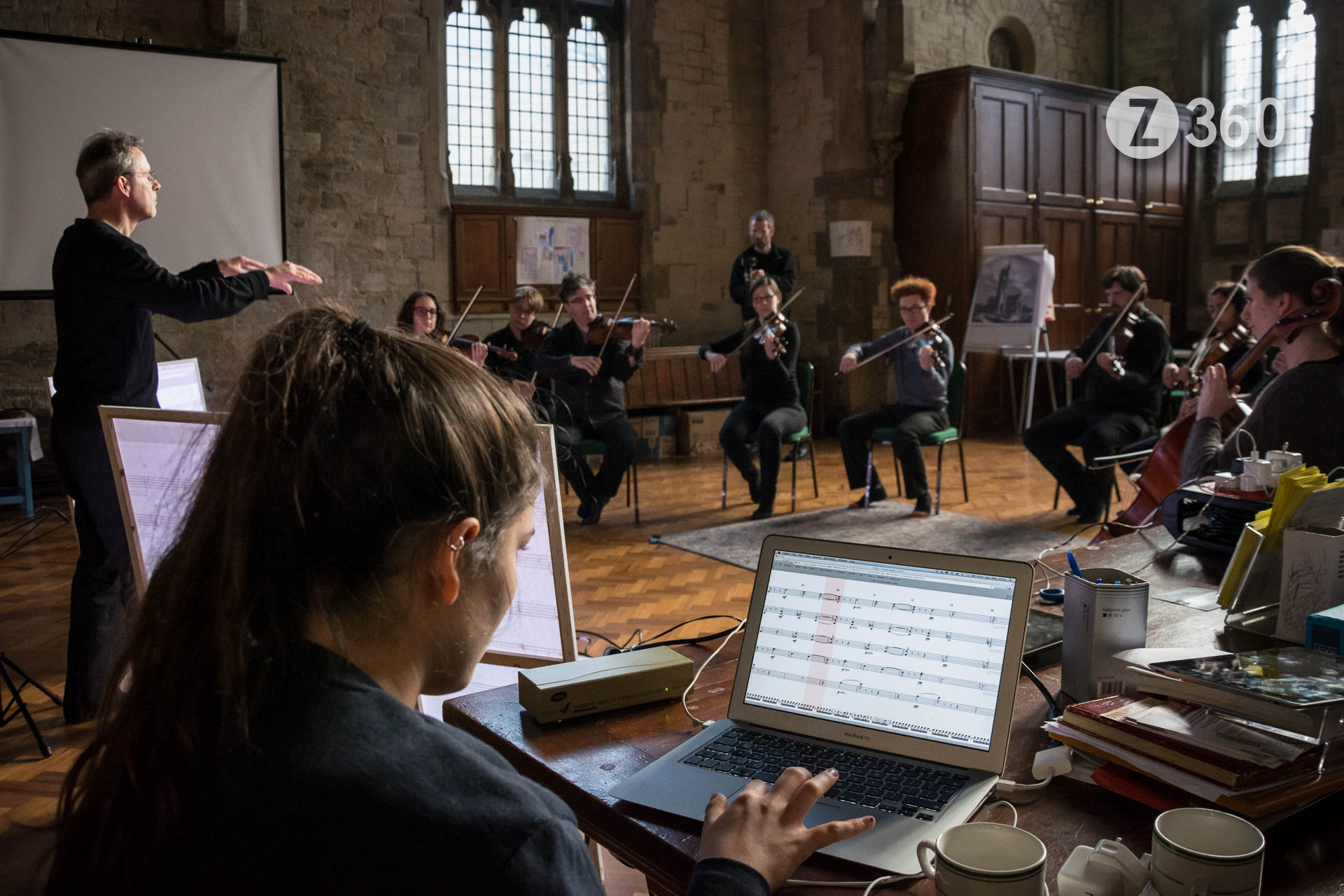
The musicians no longer need music stands as the scrolling music is projected onto moveable screens, here we are experimenting with 3 different screens.
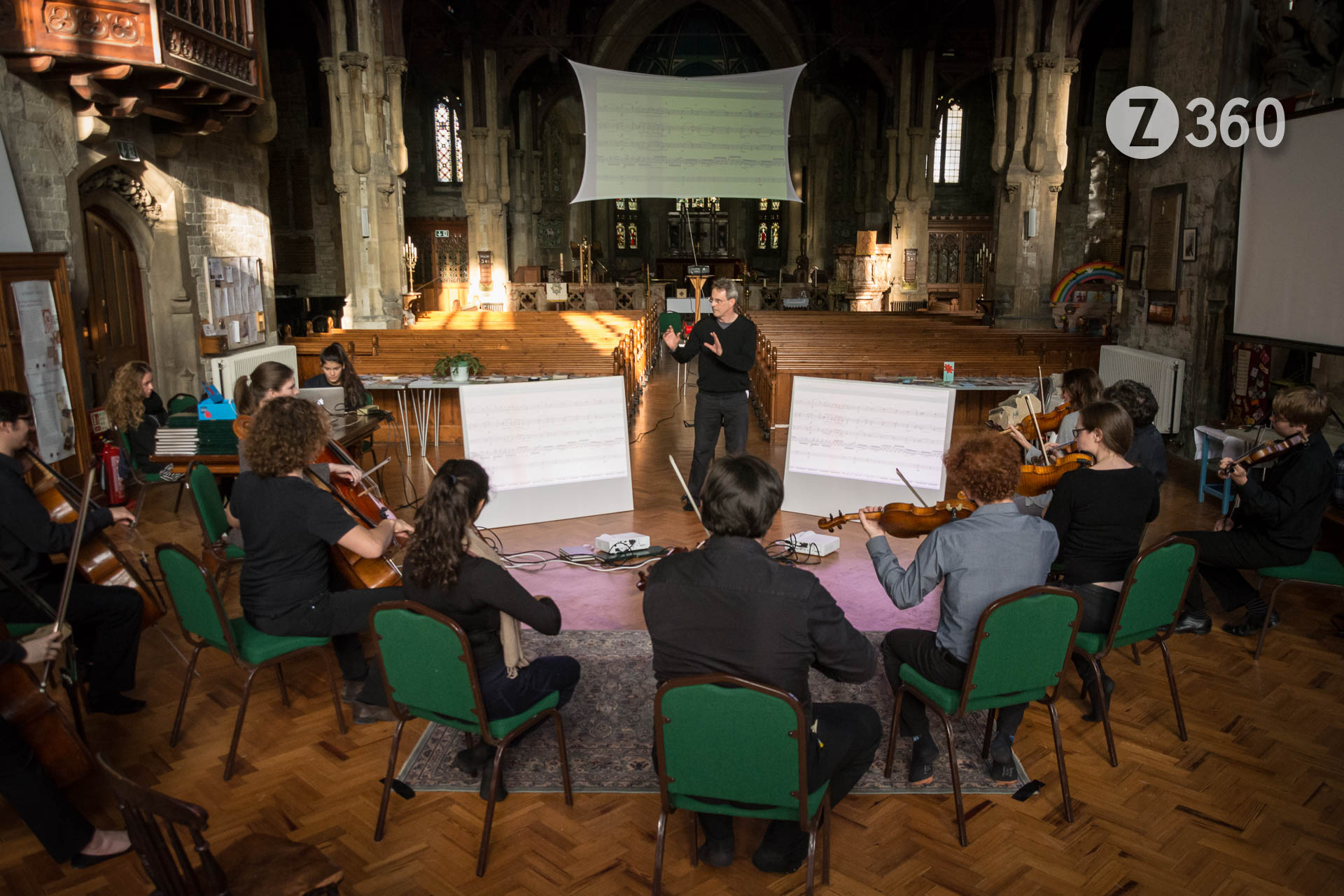
Potentially this allows free movement by the musicians during performance and brings up their eyeline to more directly connect with the audience.
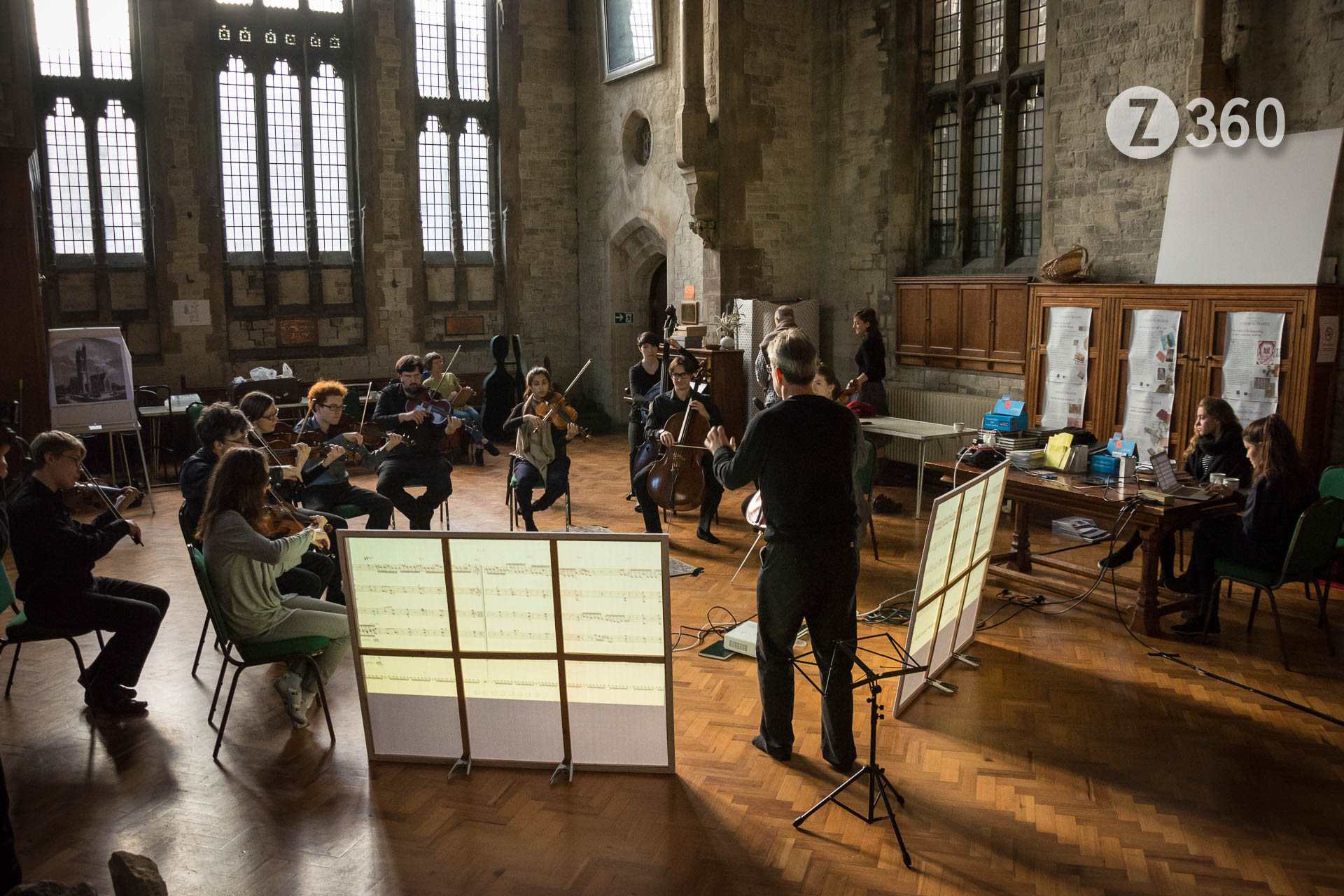
You can see more photographs here…
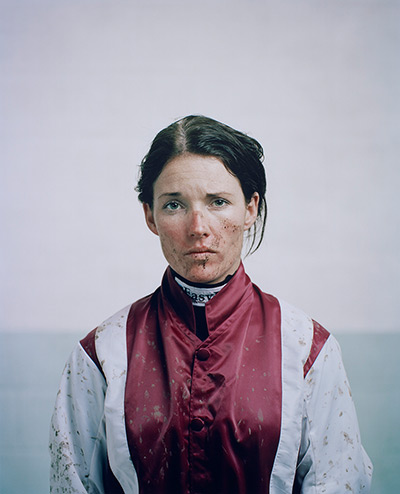
The Prize Winner: Katie Walsh by Spencer Murphy
Well the state of contemporary portrait photography does not appear to be the healthiest judging by the show at the National Portrait Gallery. Or maybe it is the judges who are incapable of choosing examples of truly photographic images which amaze and excite us. This possibility is suggested by giving the £12,000 prize to an enlarged photo booth style picture which is badly cropped and flatly printed. Many other entries appear to be box ticking exercises to fulfil some imagined social criteria not directly relevant to the art of photography. Some pictures were parts of a monograph which do not stand up when taken out of context, or journalistic commissions featuring famous people and formula photography. The number of people either sitting on chairs or looking straight to camera is stultifying and there appears to be a strange obsession with gypsies and twins. Of course there is a photograph of The Queen, in this case a tiny and unpleasant snatch shot. In these portraits nobody is doing or expressing anything, there are hardly any actual physiognomic examinations (surely the essence of portrait photography) and certainly a lack of technical exploration. The formulaic and unadventurous nature of the Taylor Wessing Prize is demonstrated by the previous years entries which could replace this year without anyone noticing.
The exhibition was cramped (£3 for 3 small rooms) and clumsily laid out with the prizewinner hidden in a corner (halving the potential viewers) and many pictures stacked one above the other making viewing difficult. The lack of respect for the skills of photography was demonstrated by the fact that there were no technical details whatsoever.
My criticism of this show was reinforced when I nipped upstairs to see the free Starring Vivien Leigh: A Centenary Celebration exhibition, featuring 2 portrait photographs by Madame Yevonde and and Angus McBean which are truly photographic images and far superior to anything on view downstairs.
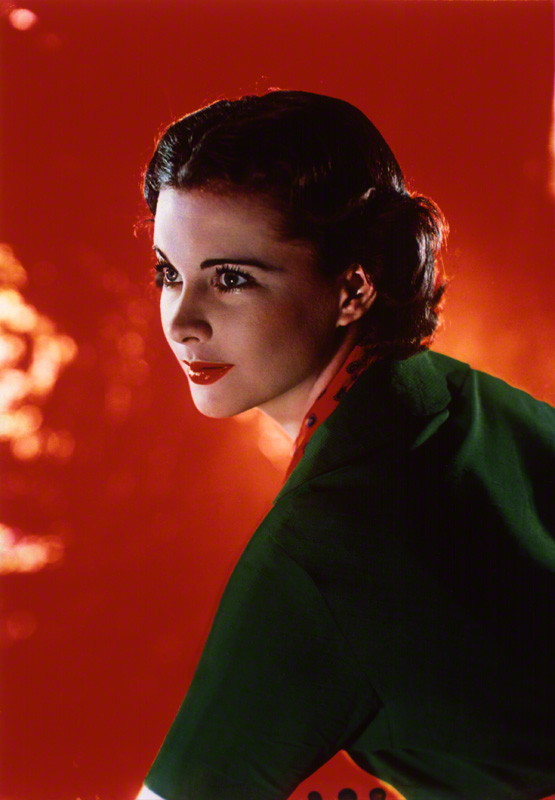
The Madame Yevonde portrait was taken at an acute angle in vivid dye-transfer Technicolor in 1936 and was more daring in its posing and use of colour than anything on view in the 2013 selection.
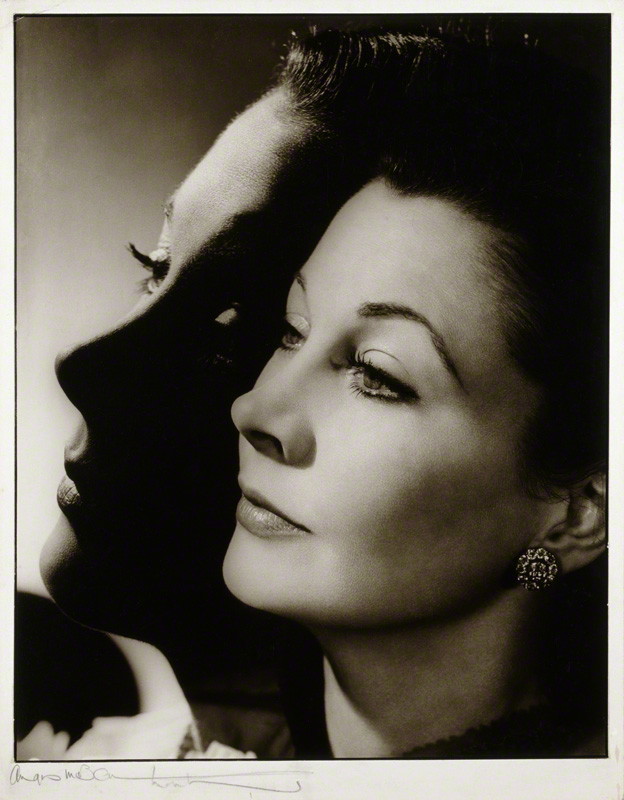
The Angus McBean portrait is a monochrome double exposure print from 1952 nearly in silhouette, both more technically adventurous and revealing than any of the contemporary work. Surely the judges could have found some equally strong work in 2013?
PS “Fabio” did raise a smile..
Postscript 2016
The Guardian says the 2016 £15.000 winner is “An apparently simple and straightforward picture of a boy in his school uniform”. The Judges say “something beautiful out of the everyday”. Oh yes the Judges have chosen another incredibly boring photobooth shot !
Paul Shearsmith’s Volvo Amazon in Mario’s Cafe, Kentish Town
Life size car photography by Douglas Cape, Z360